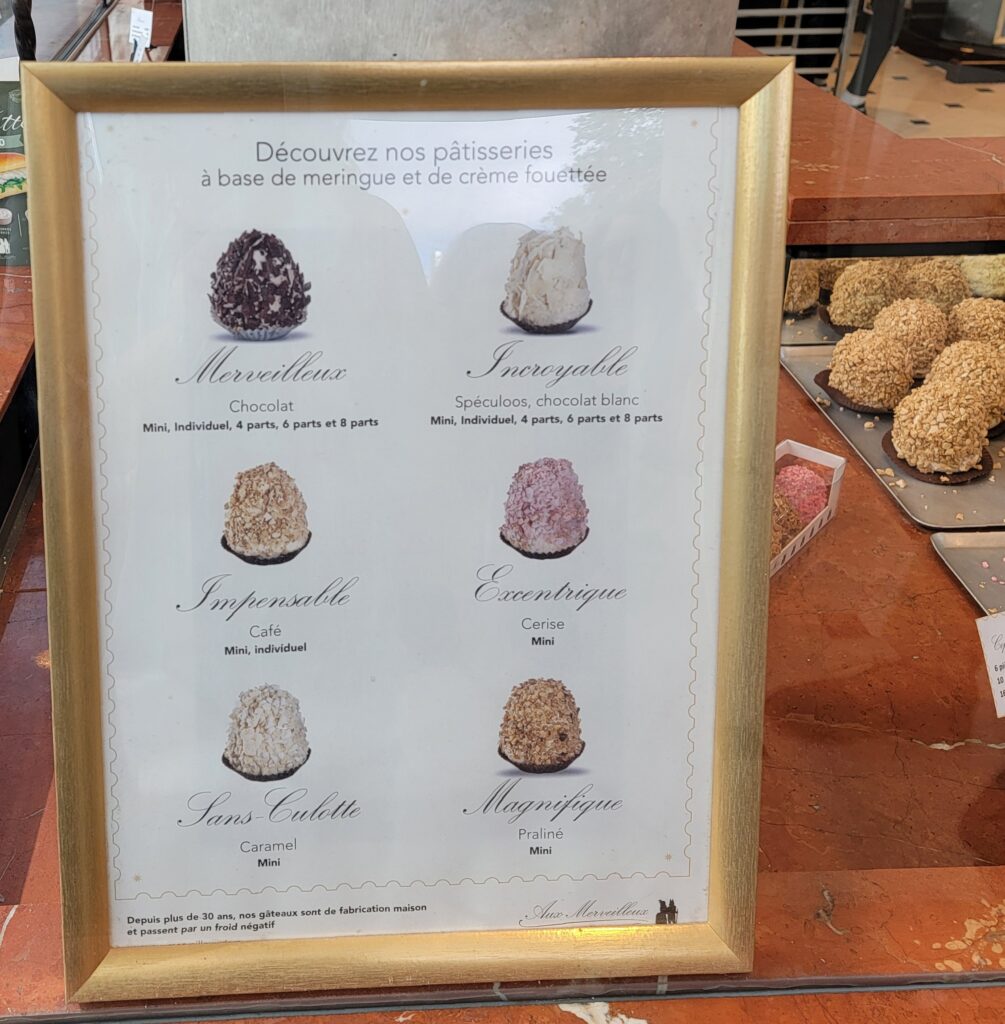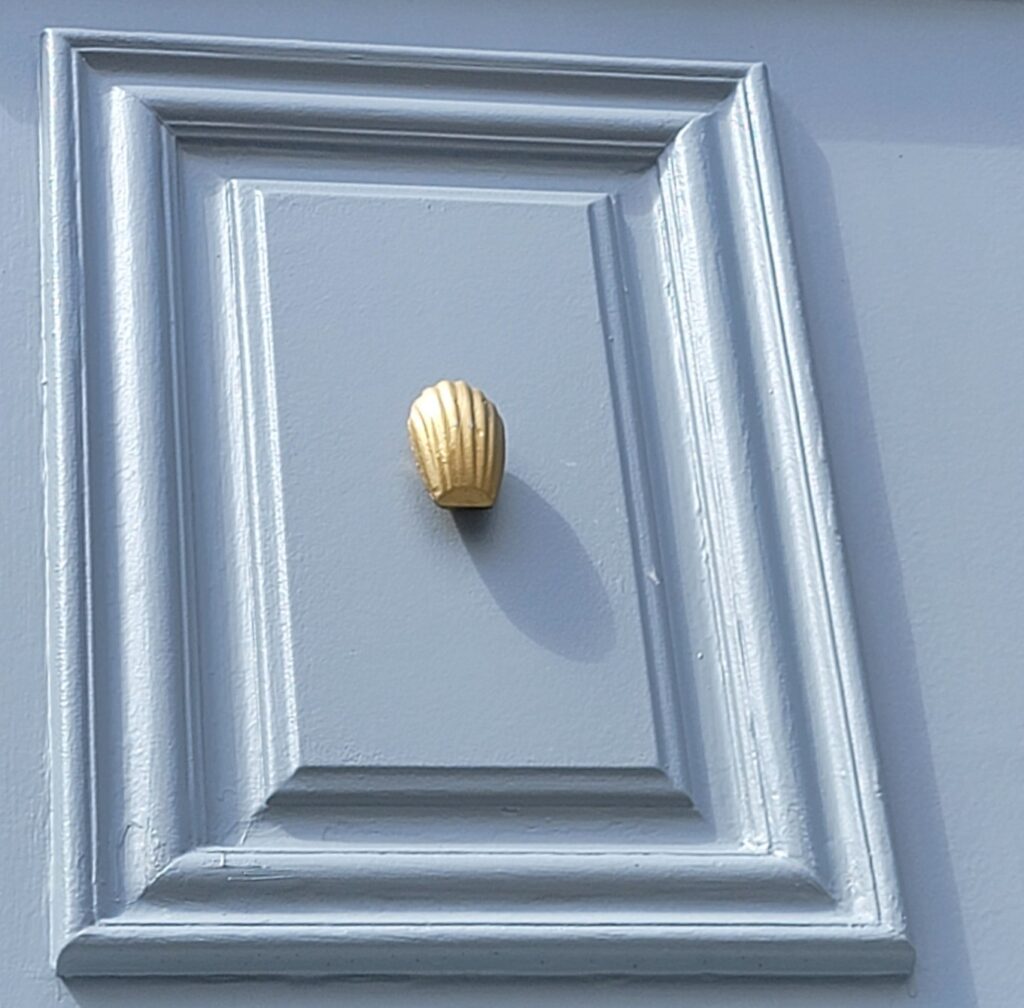Today, we did a “Wine, Cheese, and Patisserie” tour of Montmartre. What a great way to see this part of the city!
Right as Leann and I exited the Metro we were at the Moulin Rouge. This street, “Pigalle,” was the border between the 9th arrondissement and the 11th – which was tax free. Therefore, the 11th “side” of this street was the ‘best place to party’ (and where the Moulin Rouge is located). People would “sneak out” of the more bourgeois parts to party with the artists, painters, actors, singers, and dancers. This area was the most important area for this sort of “artist culture” as our guide, Hugo, put it.
In 1886, Toulouse Latrec was the master of the parties in the area, whether at the Arc de Triomphe (which was a big place to party) or at the Moulin Rouge where he is now well known (especially via the movie). The actual mills on Montmartre in the 14th Century ground anything that needed to be ground – grapes, flour, stones, etc – so the plaza outside the Moulin Rouge (where we were standing) was referred to as “Place Blanche” because it had a fine covering of the flour/stone/etc from the mill that was located here.
At the end of the 18th Century, the Moulin Rouge was the first building to be electrified in Paris.

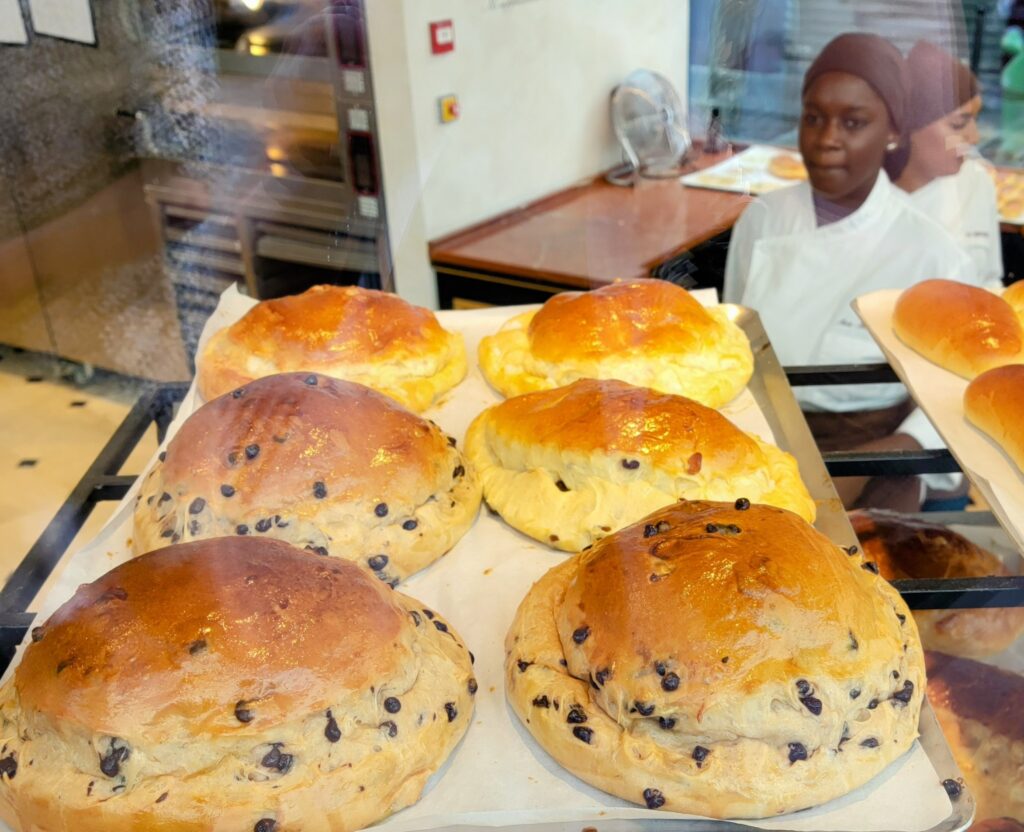
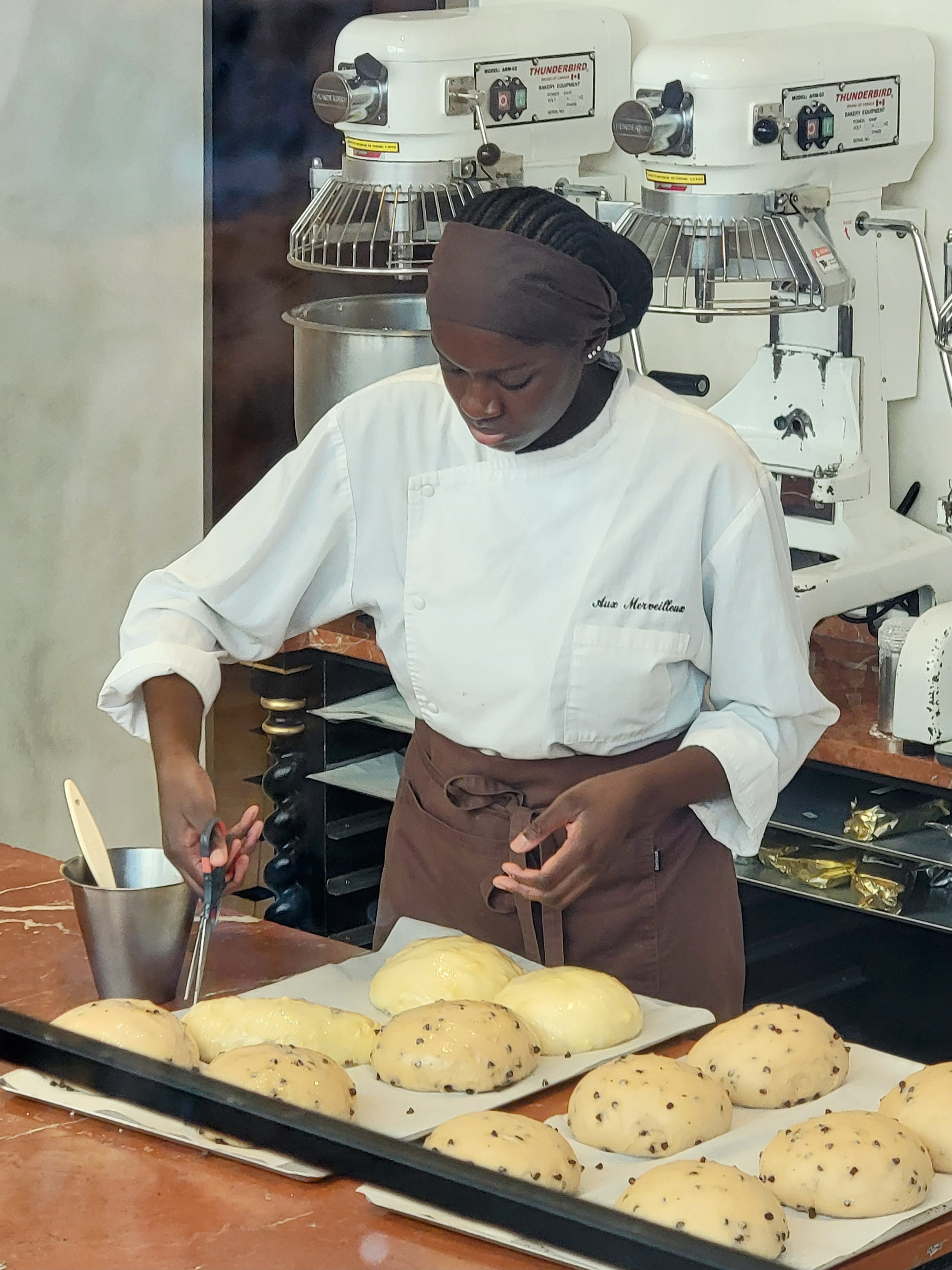
After hearing this history of the area, we headed for our first “treat.”
I was quite taken actually by the baker making enormous brioche in the back of this bakery, but we were treated to treats made from an old recipe that had been recently revived. (In the photos, she’s snipping the tops of the brioche so they cook right – you can see the line in the cooked ones.)
Our treats had a very thin meringue base, with flavored cream on top and a bit of a nut or flake shell to keep it all together.
Which flavor would you have?
Phryges again – this time on a UPS-type delivery truck. And in a hammock!
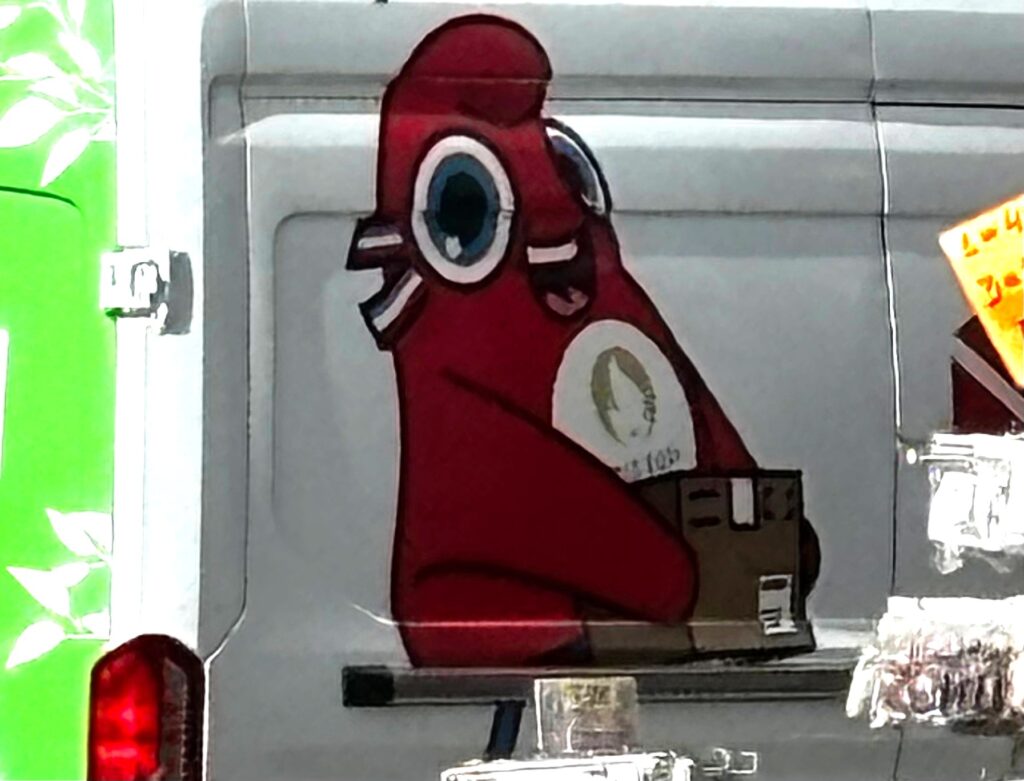
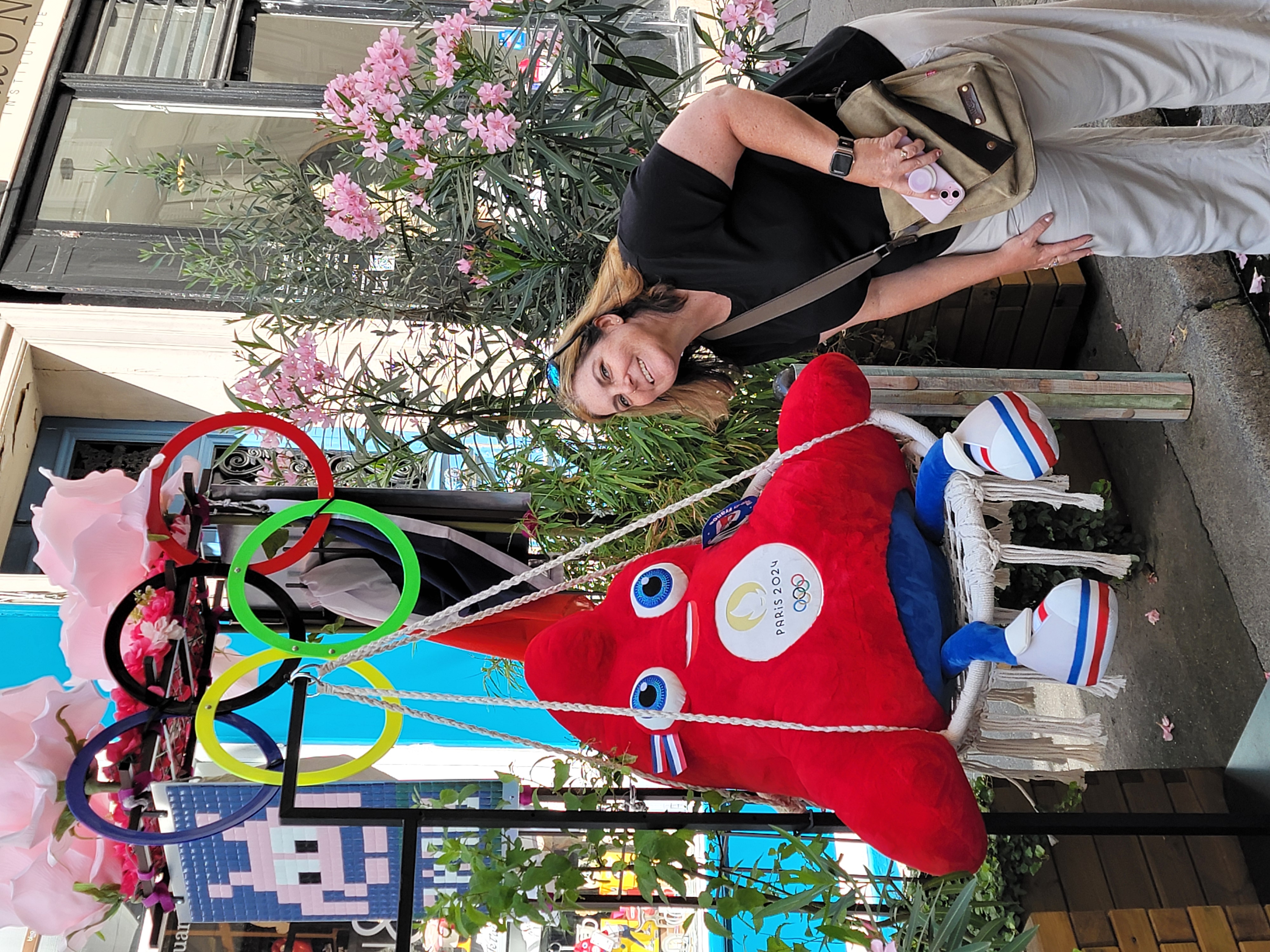
Next? “French” onion soup from Chez Marie. The story is that the king was hungry late one evening and started throwing things together, because he really didn’t know how to cook, and this is what he came up with. :-) However – get this – onion soup went to the USA with French immigrants, and then (per Hugo) Italian immigrants there added the big cap of melted cheese to it! Then, it “emigrated” back to France, and the grilled cap of melted cheese became A Thing.
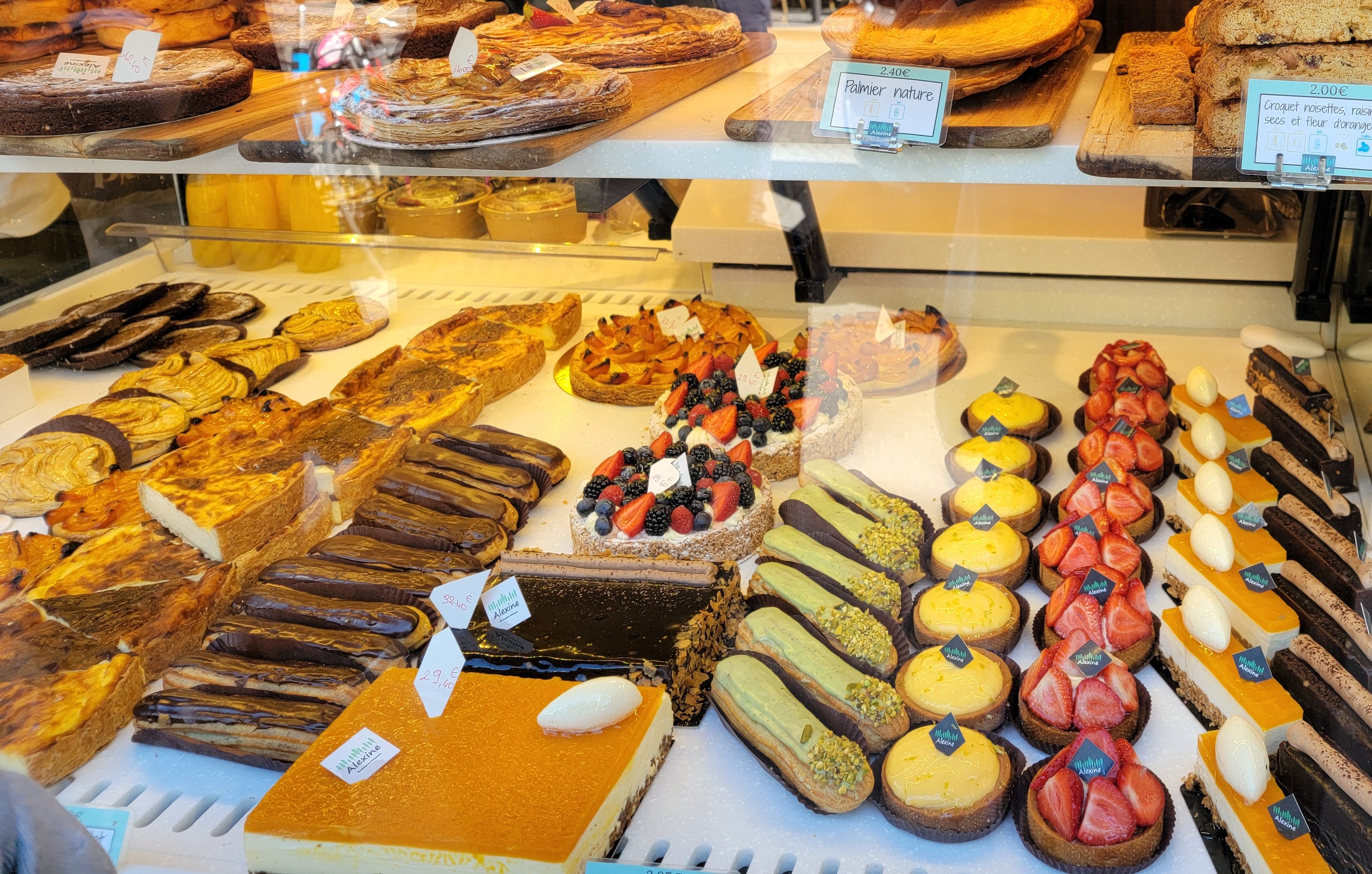
I learned a new word, “Quincaillerie” – which basically is an “old” word for an “Everything Store.” (Hugo said it was the sort of word his grandmother would use – there are a few of these stores throughout Paris and I hadn’t known what the word meant.)
Next was a *delicious* quiche. Hugo had quiche Lorraine, and a leek quiche, and we all had a big piece. (I took the leek quiche as the quiche Lorraine uses pork belly and I try to not eat pork.) Alsace-Lorraine is in the Northeastern part of France, and was taken over by the Germans for a while. But as Hugo said, these folks are known to “never give up” and it is now back part of France.
This region is known for folks working in the field, and so a quiche was a way that you could have a crust, eggs, and “left overs” for lunch if you couldn’t get home, in a “grab and go” fashion.

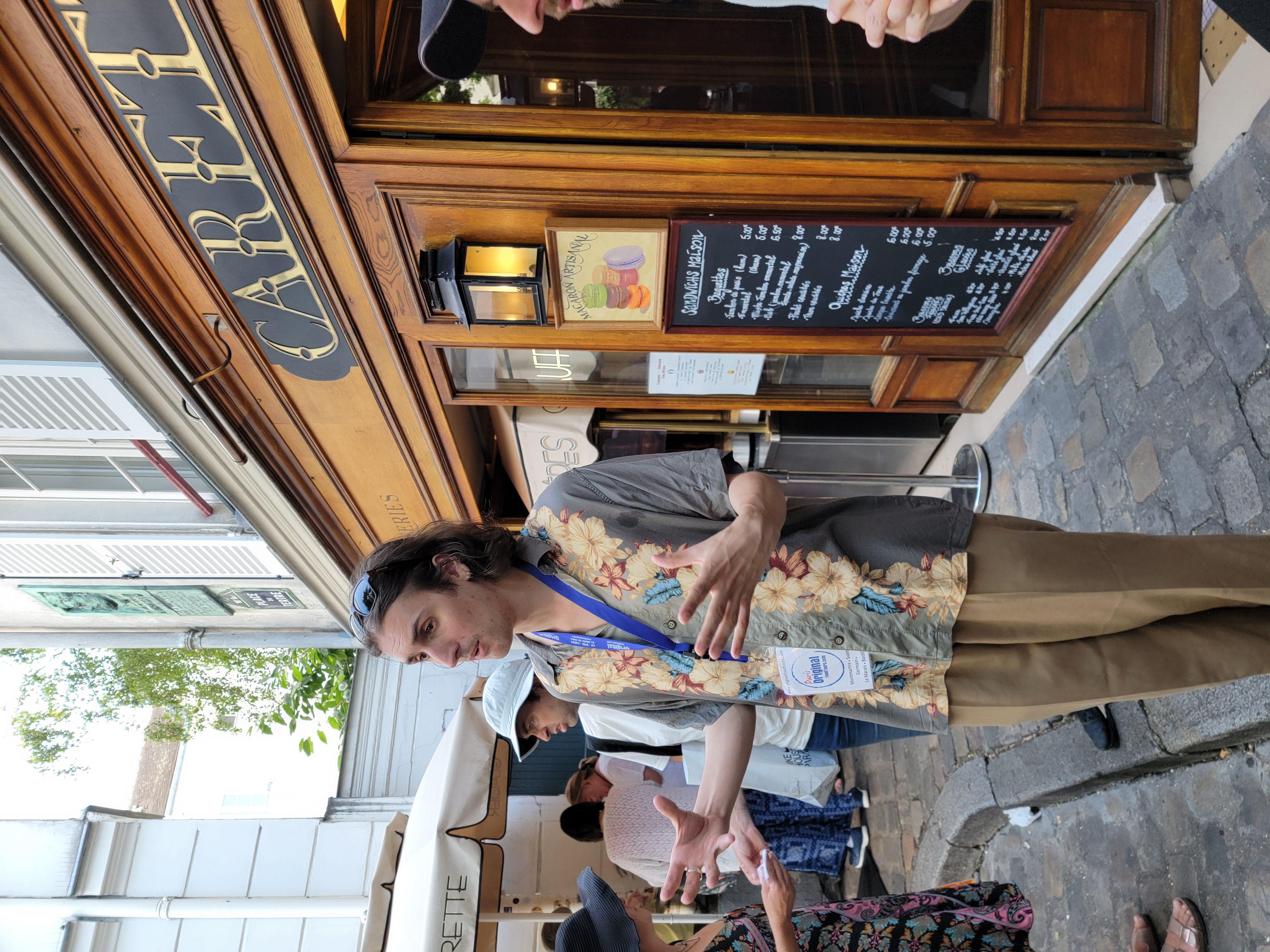


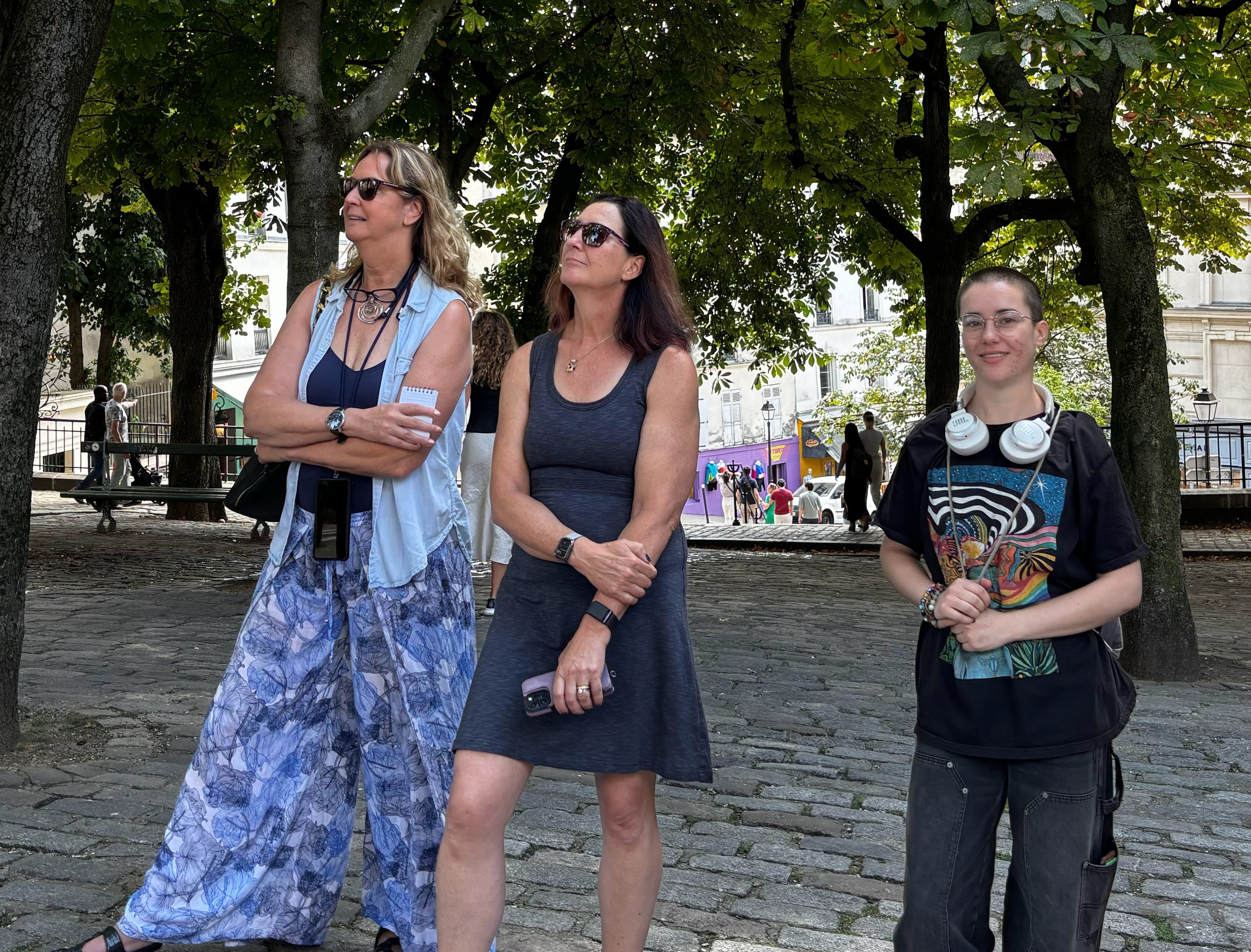
As an aside, to be deemed a “boulangerie,” legally you must make the dough at the bakery. They get up at 4 a.m. to get the dough going, rise, etc, sell it all day, and then give it over for example to be in the bread in the top of onion soup the next day.
Here’s another super interesting fact. Baguettes are only like 120 years old. How could that be, for something so synonymous with “France”?
Originally, miche was the bread made in Paris. You would bring one with you, and cut it up with your knife to eat it. However, when the Metro diggers were working underground they got a bit stir-crazy and started knife fights. Knives were therefore forbidden. So, how could you bring your bread and cut it up? You couldn’t. Therefore, the baguette was invented, because it was a bread that you tore up to eat.
Another word origin that was related to this was the French word “Copain.” It basically means a “pal.” The usual word that you’d use would be “Ami” for friend. But back in the dark in the Metro, you would refer to someone that was “okay to share your bread with” as a co-pain (“pain” means “bread” in French). Aha!

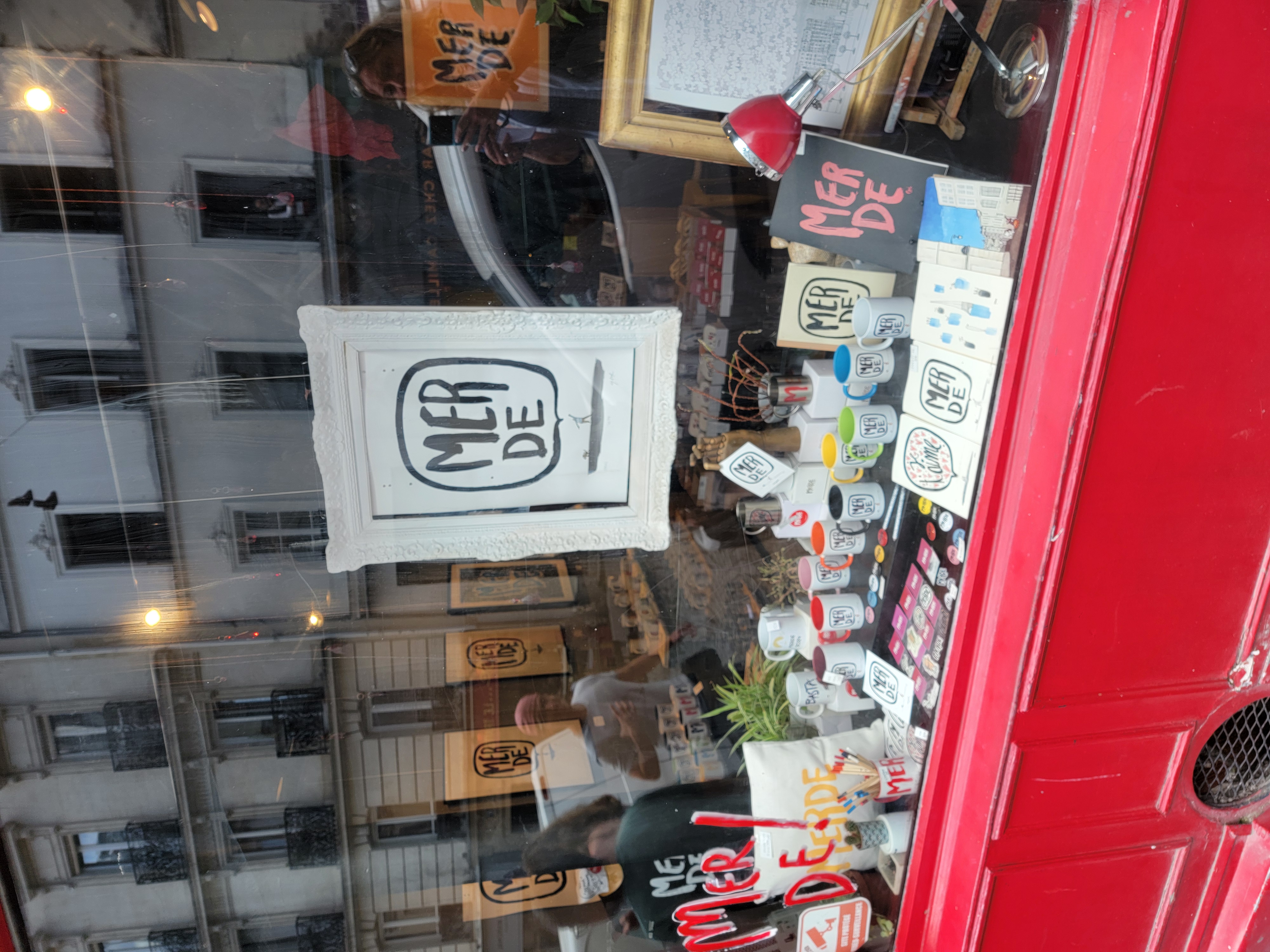

We passed by some marvelous shops just on the street, including my personal favorite, the “Merde” brand wine shop. If you’re going to name your wine “Merde” it had better be good – and apparently it is. It has been served at Macron’s parties. (The shop wasn’t open or I would have raided them.)
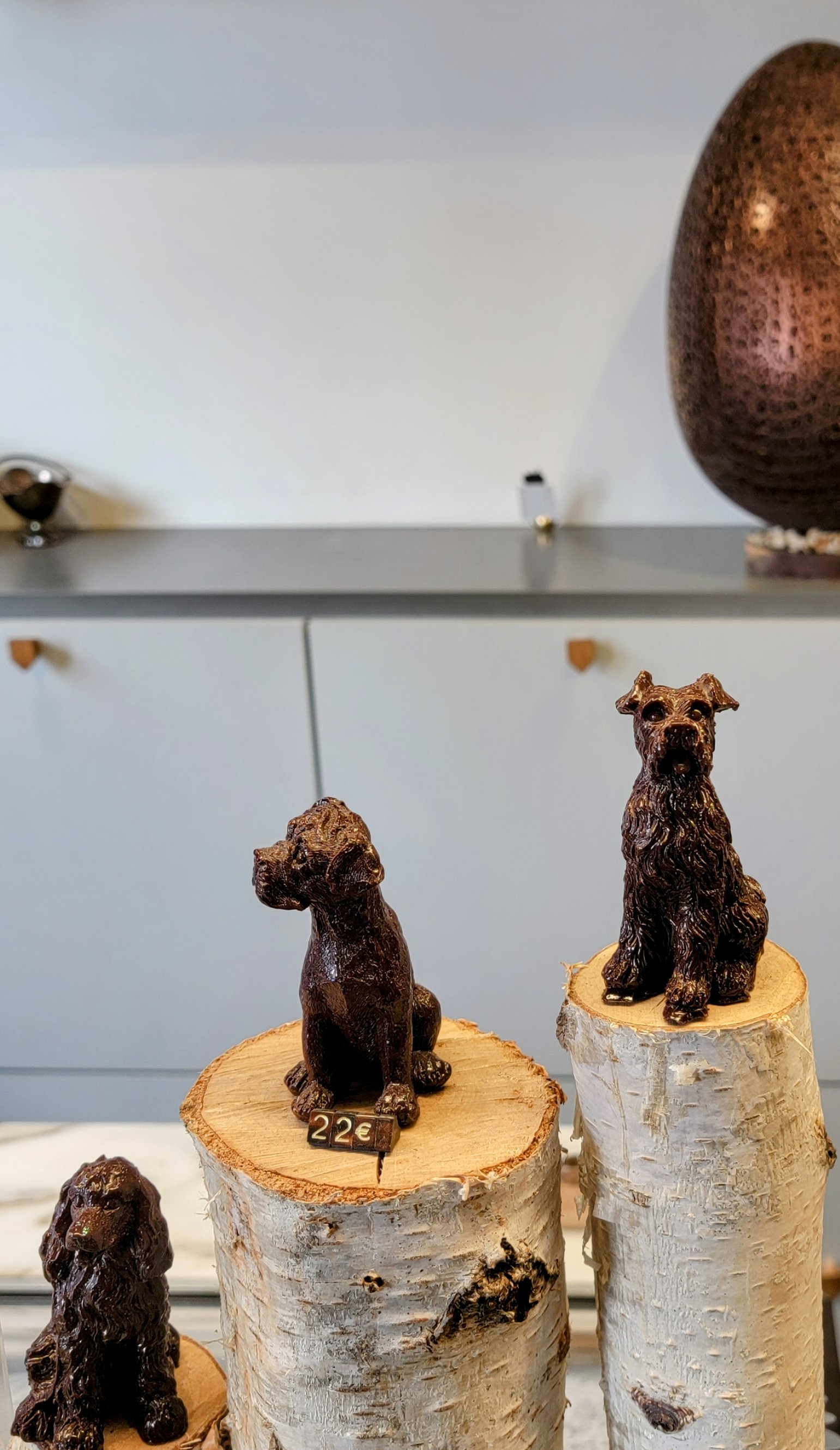


After this, we were treated to chocolate from Chocolat Ilene. It is well known in Paris because it is excellent chocolate, but the cooks are Korean and like to mix in Korean tastes. The chocolate that Hugo got for us to “make us guess” turned out to be wasabi (I didn’t taste it). All I cared about was that it wasn’t Kimchee chocolate!!!! I went inside to see the chocolates that they had hand-crafted (the middle egg is *solid* chocolate) and the store was quite cold. They were very strict about you shutting the door after yourself. Our guide had told us this, but tourists were walking in and out and just holding the door open – the chocolatiers were getting a little irate. At least we were forewarned and were “good” tourists.
Another interesting fact: Chocolate was originally served as a liquid. Marie Antoinette was *crazy* about chocolate. She apparently had very severe headaches, and wouldn’t take her medicine, because (per our guide) she was stubborn and spoiled. Therefore, the doctor had chocolate made into a solid so that he could put the meds into it. !!!


Our next treat was Choupettes de Chou Chou. Our guide told us that you always buy a whole bag of them when you need a present. He also said that it was (his words) a “strong move” if you need to apologize. It says “Please, be kind to me.” He told us a story of missing a deadline in college and bringing a sack of 20 of them to his professor (and it worked). He also said that the best part about giving folks a sack of these is that the person you give them to then “becomes a hero” as s/he would share them. “Chou Chou” is a pet name, and “Choupette” is a bit of a “pet name” for these pastries. (NOTE: These are what we received from the hotel, from Odette – one of the top ones in Paris)
Hugo then told us about the Wallace fountains (we walked past one). He made the point that after 1872/the Prussian invasion, the Prussians besieged Paris for almost a year and broke all the aqueducts. Therefore, the Parisians moved over to wine instead of water – which made them basically alcoholics. Wallace, an Englishman, gifted them to Paris. (We had heard about them during our Marais tour, and you saw photos of them back then.)
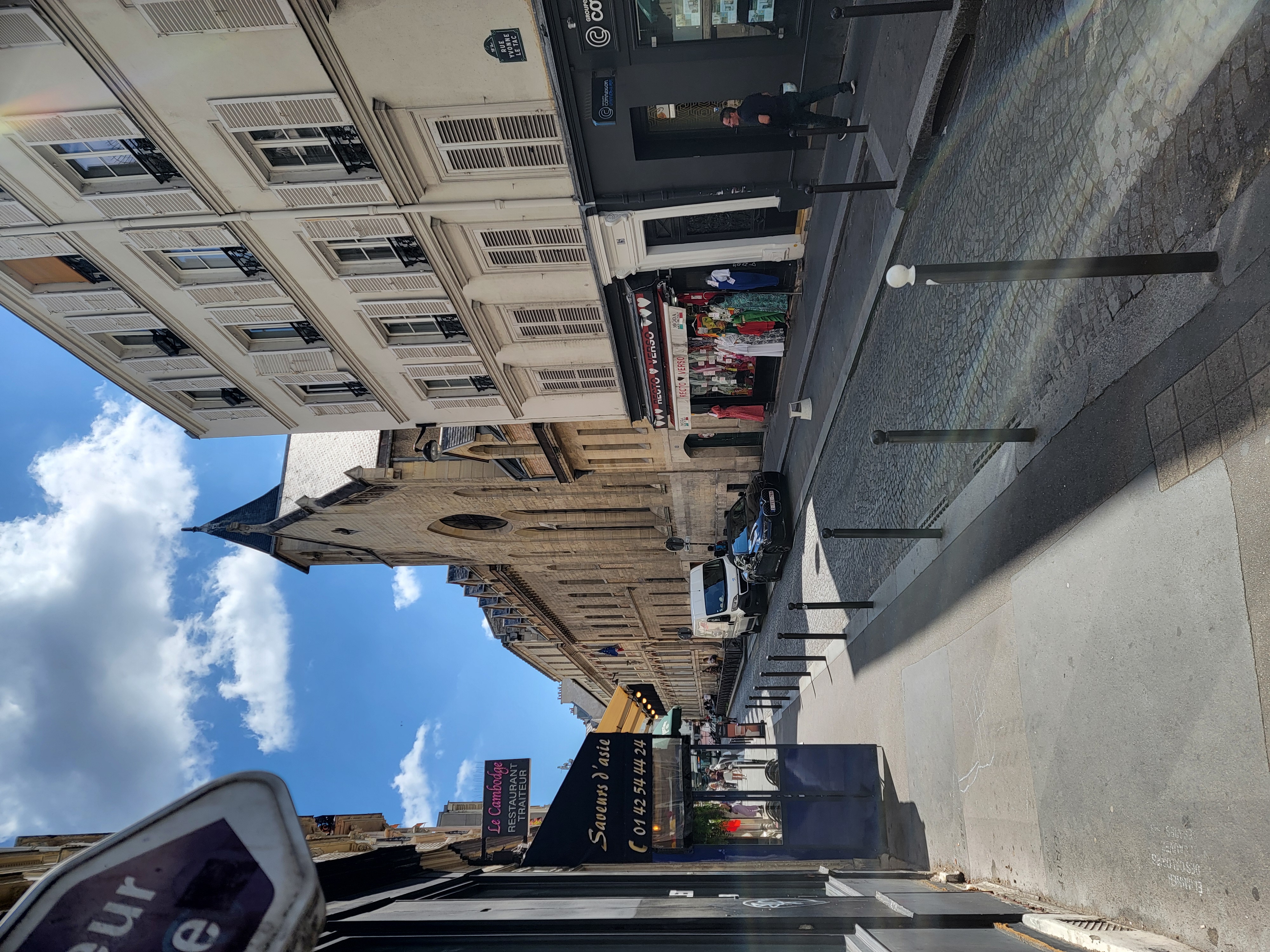

We learned about St. Jean Des Abbesses church, which took 10 years to build and was opened in 1994. It is the “little sister” of the 1st church in the area, which is now more of a Catholic family “gathering place,” further up the hill. While most folks were Catholic for a long time now there are far fewer, so they turned the 1st church into a Catholic community gathering place.
Our guide, Hugo, grew up on Rue Des Martyrs. In the 1st century, this area was still Roman, and as we all know, Romans weren’t crazy about Catholics. Saint Denis was preaching the Bible, which the Romans definitely did not like – they killed him to keep him from spreading “this poison.”
The story is that the two soldiers that were supposed to climb St. Denis up to the top of the hill and behead him “got lazy” mid-climb and instead beheaded him on the spot we were then standing. Supposedly, he fell, got up, grabbed his head, and walked up to the top of the hill to die there. (Name of the area? Mont-martre – hill of the martyrs).
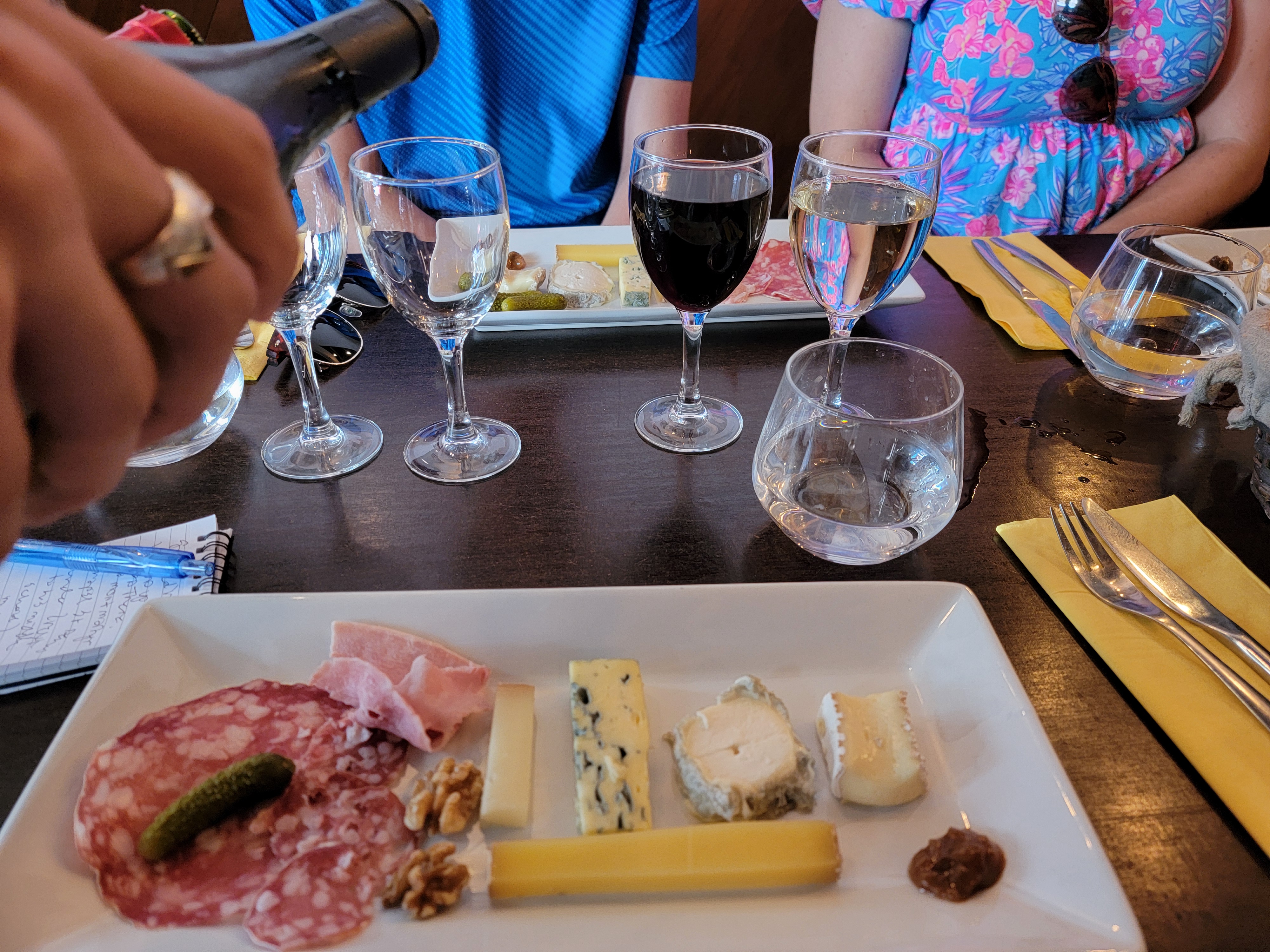


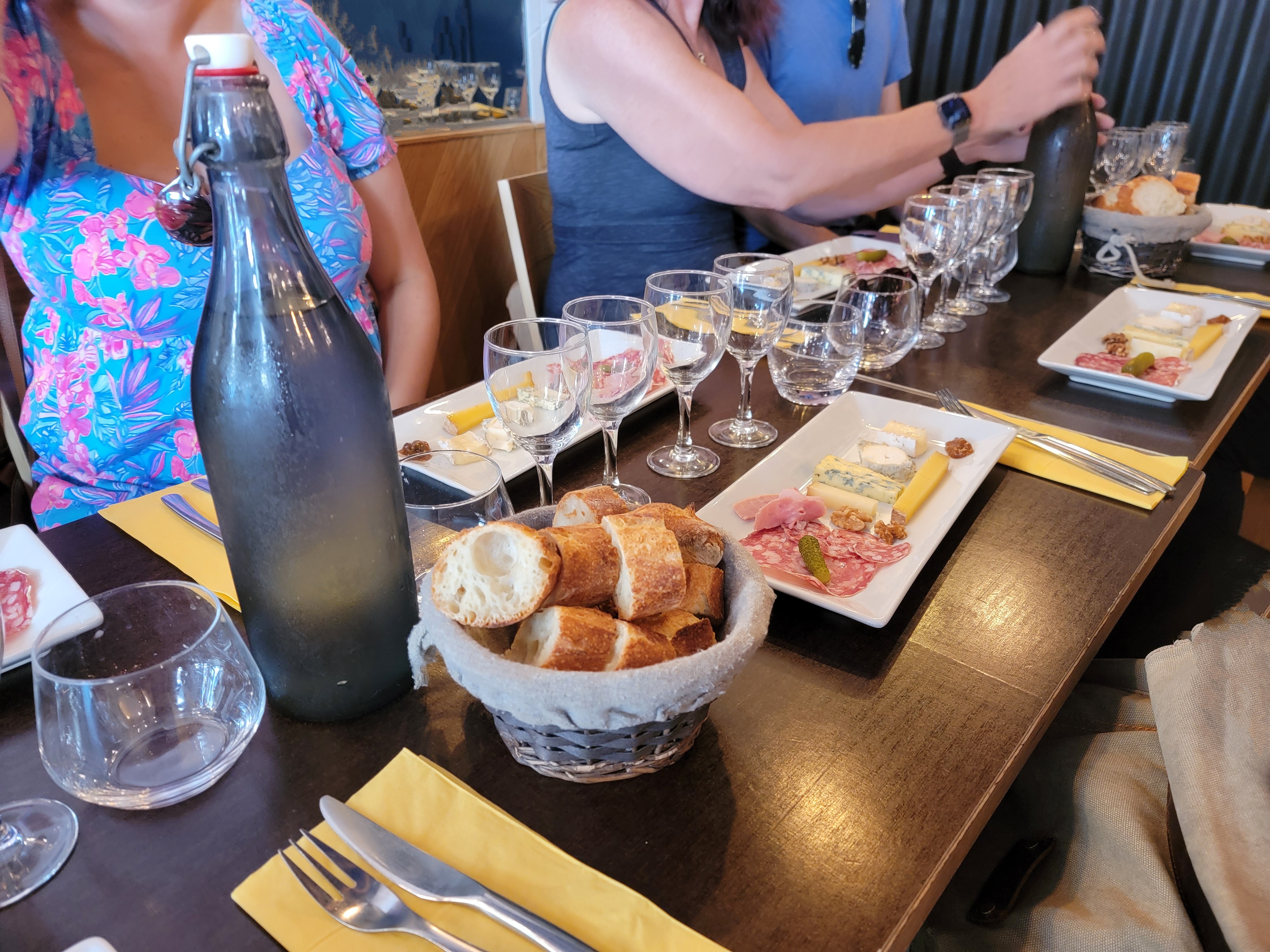
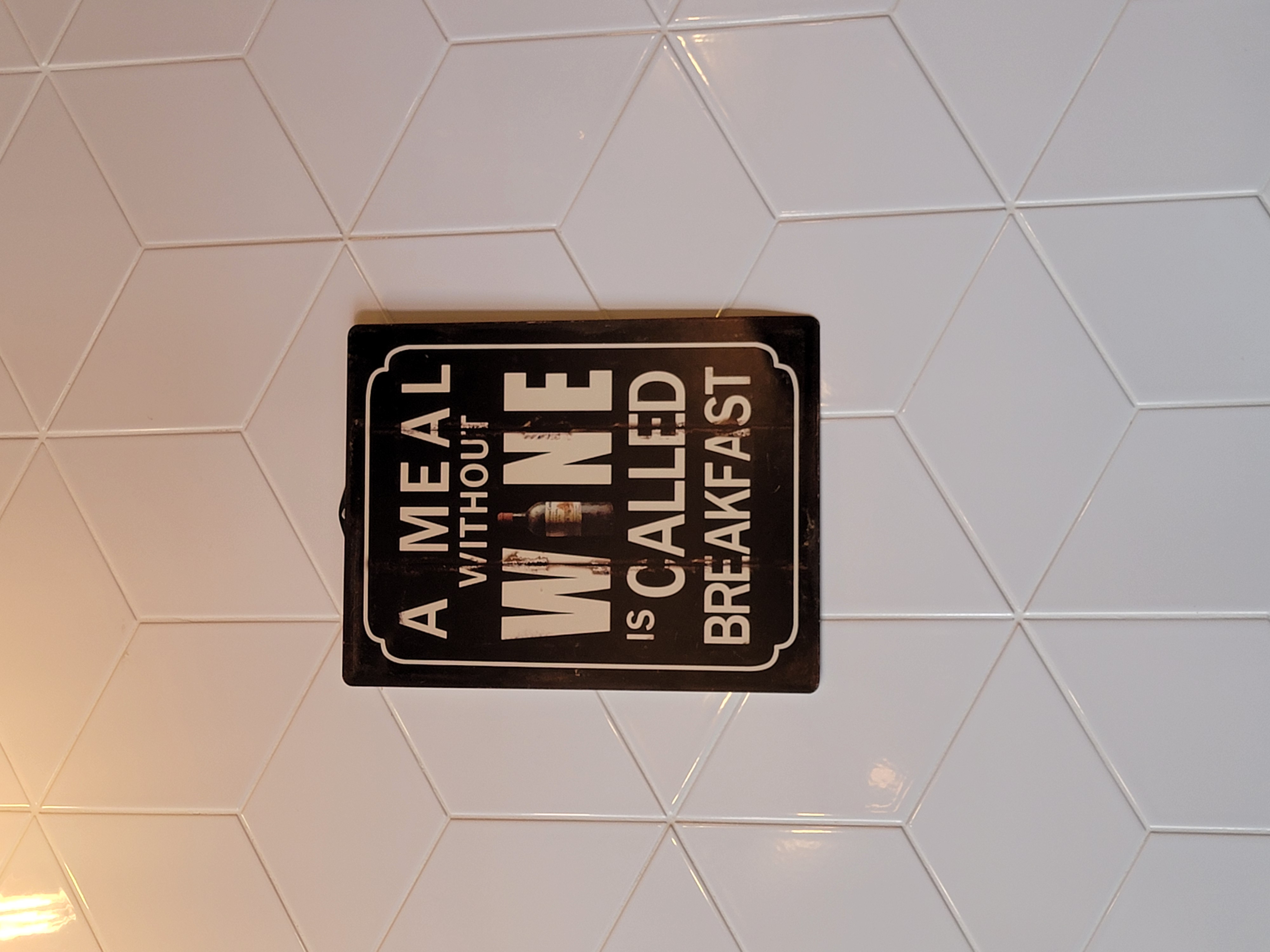

Next, we were treated to a baguette, cheese, and wine sit-down, The cheeses were:
*a 12 month old Comte (our current favorite cow cheese)
*an Ossau-Sraty (that doesn’t seem right, but that’s what I have in my notes and seems to be written on the bottom of the board)
*a bleu d’Auvergne (very very “light” blue cheese)
*Saint-Maure-de-Touraine, which is a goat cheese; it has a hole in the middle, which means it’s good/young…they put it on like a brochette stick and roll it in vegetable ashes…if there is NOT a hole, then the cheese isn’t fresh, it’s filled in
*finally, a Brie de Meaux. Hugo told us that Brie is one of the first things that kids eat as babies.
All their cheeses are unpasteurized.

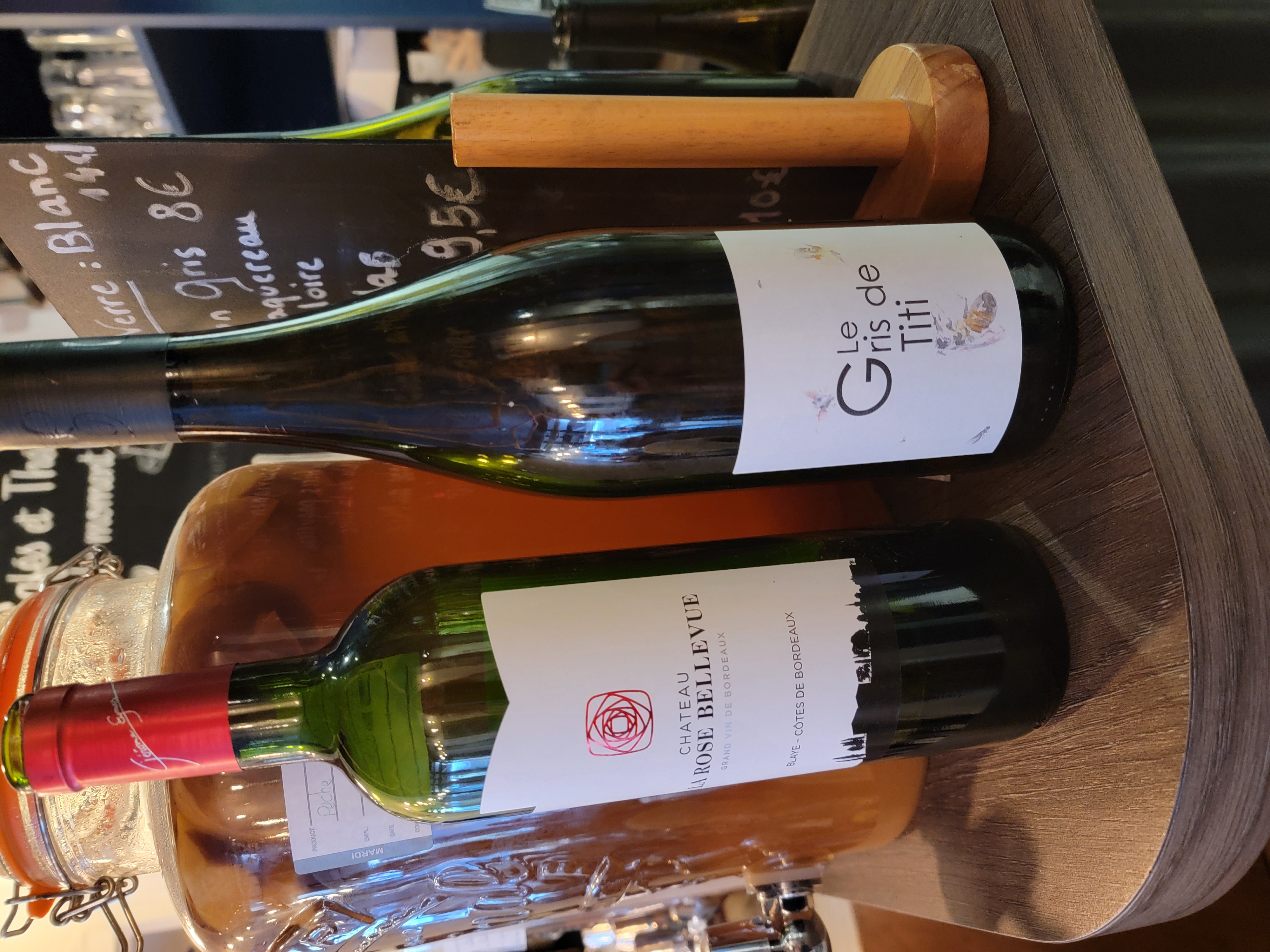
The wine was a Bordeaux-blend red from Bellevue. 75% merlot, 25% cabernet. Hugo said that the Bordeaux bottles are said to have “noble masculine wine shoulders.” (As opposed to a Burgundy/pinot that has “sloping” shoulders.) It was a bit “merlot-sweet” with light tannins, red fruit and spice on the palate. Once it sat for a while it opened up and you got a bit more of a hit from the Cabernet, but it was always quite soft.
The white wine was “Le Gris de Titi” – a sauvignon gris from the Loire. Titi is actually the name of the owner of the restaurant where we were eating! This wine had a honey or white flower nose, but then was more “grey rock” on the tongue. I liked it.
Next on the eating “menu” were madeleines from Gilles Marshal. They are originally from Alsace-Lorraine (and were SO delicious – not like any “madeleine” I have ever tasted). The story goes that in the 15th century, King Stanislaus was a big party giver in a smaller version of Versailles (think it was *in* Lorraine). He ran out of party desserts and asked his servants to make something quick. A girl spoke up and made a butter-based small “cake” and baked it in coquille (scallop) shells (which were in the kitchen to be used for coquilles St. Jacques). The girl who “saved the day” was named – you guessed it – Madeleine.
There is actually a phrase in French called “un madeleine de Proust.” A “madeleine de Proust” is an expression used to describe smells, tastes, sounds, or any sensation that reminds you of your childhood or simply brings back emotional memories from your past. Proust used the smell of madeleines and how they made him hearken back to the scents of his Aunt Leonie’s kitchen in the book “In Search of Lost Time.” If you want to read more about it (it’s fascinating), go HERE.
In Montmartre, the bottom of the hill was more “working class,” whereas the top of the hill were more the artists, singers (Edith Piaf, Dalida), dancers, etc Picasso’s “Blue Period” and Cubism started here – supposedly to try to find a way to show a body without details, as many of the women had contracted syphilis, which causes big marks/welts on the body. Picasso had always been inspired by dancers, and many of the dancers had “another profession” because they did not make that much.
“Le Moulin de la Galette” (a salty crepe) was next on our itinerary. For centuries, the mills around Paris were owned by a great Prussian invader family. Then, in 1870, Napoleon III (remember him? Of shooting Victor Noir “fame”?) – 100 years after the revolution – (my notes say) “was taunted by the Prussians and lost because they were such huge fighters.” However, the Prussians “then decided to just walk to Paris and take it,” but “at the time of the French Revolution, everyone owned a gun.” I have some more notes about the Belleville area being out in the country and was taken, but next door, Montmartre was too difficult for cannons and fought like Hell and so wasn’t taken, though the invaders broke all the aqueducts. The owner who had owned all the mills (and had fought for the enemy) was cut up and his parts were strung up on the vanes of the windmill.
Then, my notes say “Revolution -> Riots/flee to Versailles -> tough time/brought back the Republic in the middle of Napoleon. People on the Hill fought so hard that the sewers were completely clogged with bodies and blood. Napoleon annexed everything to keep control.” Yes, if I had more time, I would have tried to make sense of these notes, but, Nope. (Sorry!)
Many, many artists painted this mill – on the side of the Moulin restaurant are copies of portraits by Renoir (“Bal Des Galettes”) of either the owner, or Renoir, and his wife dancing – plus there was a board up about Van Gogh and his painting of the area.


The above were found in a little park that our guide had always liked from when he was young. As you can see, it features a statue of St. Denis holding his head (since we are now at the top of the hill). The mosaic floor as you step into the park shows the quintessential French boat that you see everywhere, especially along the Seine, which represents the symbol of Paris that “France floats but never sinks.”
We learned where the word “Bistro” came from. HERE you go.
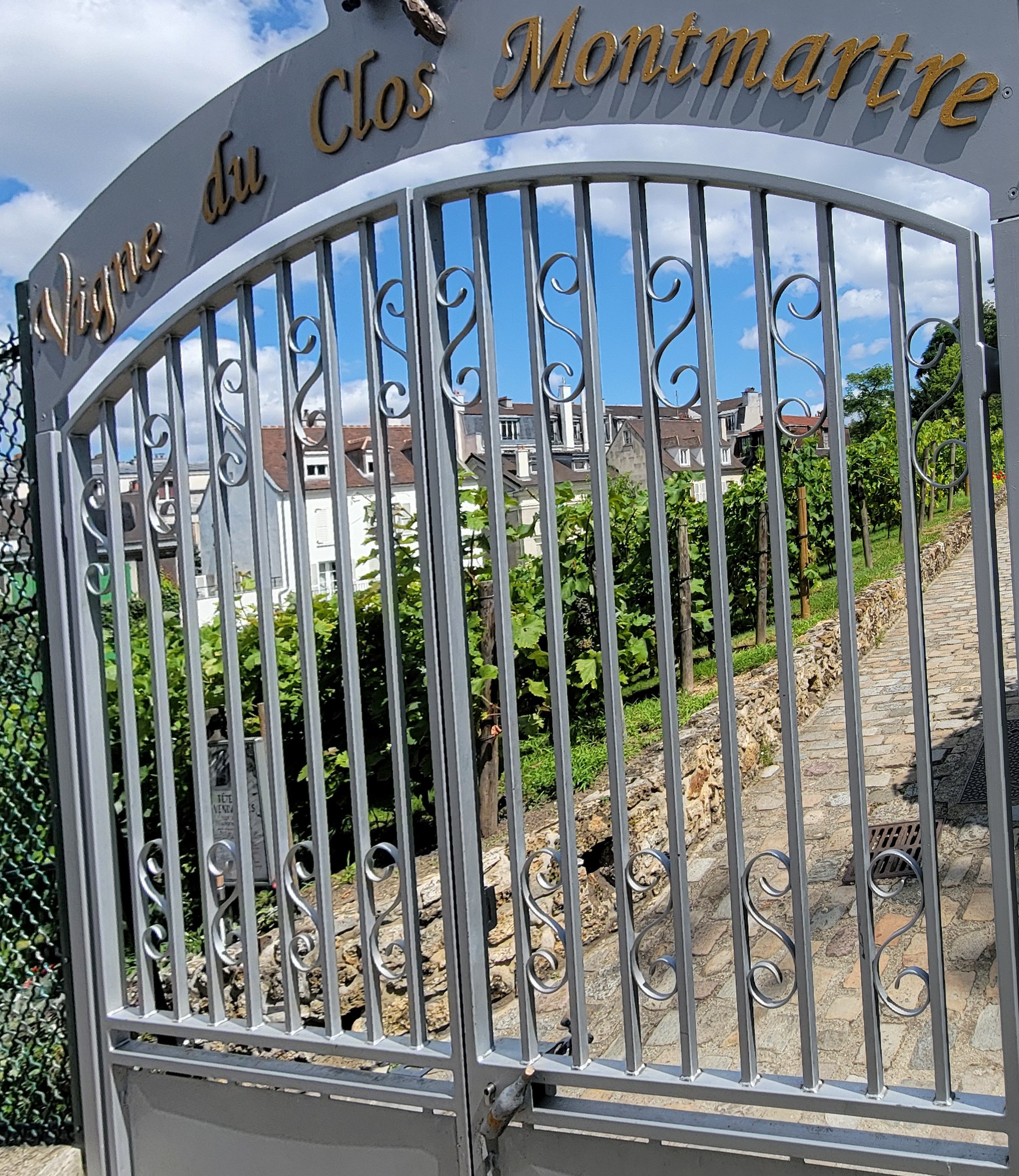

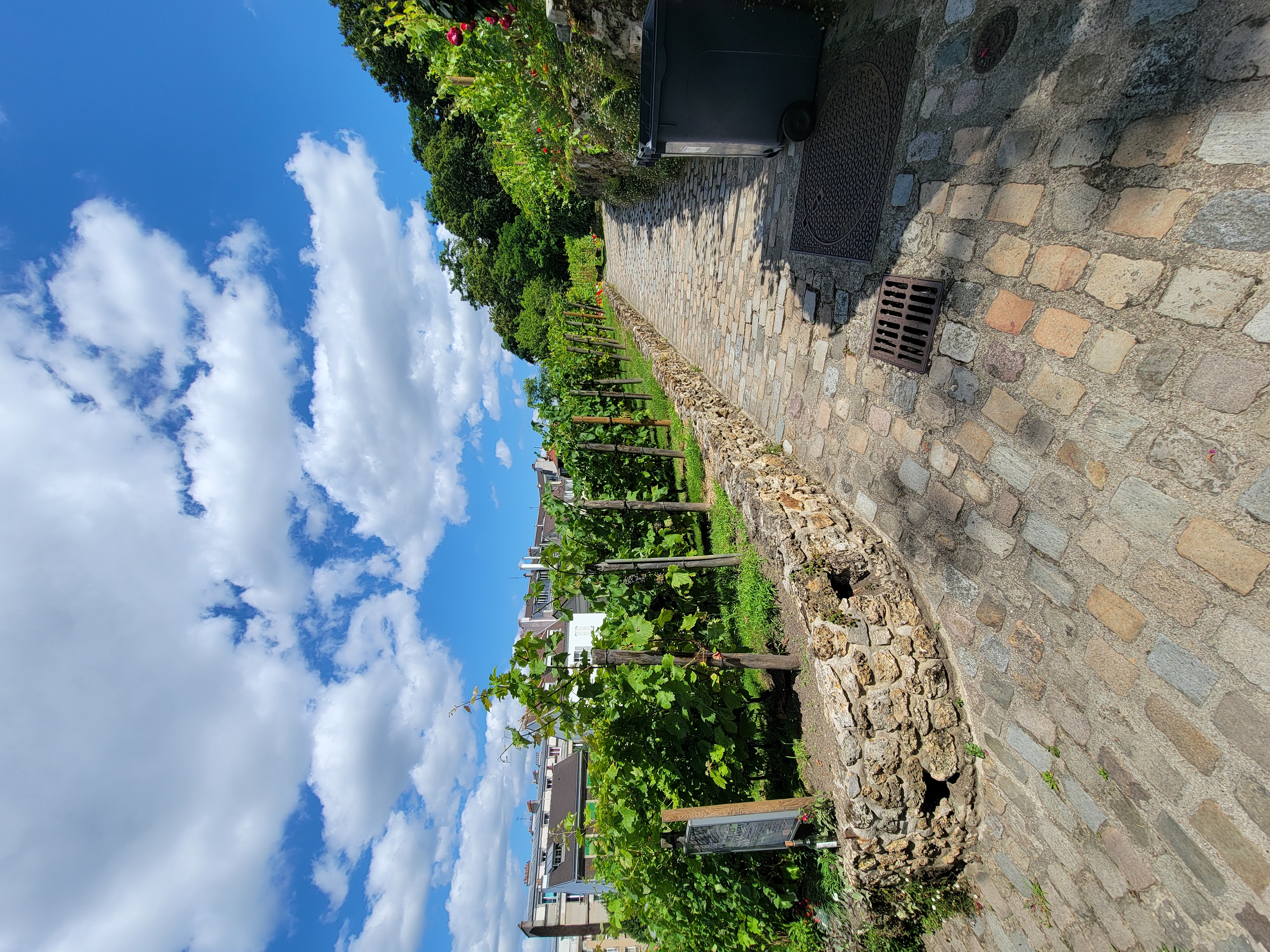
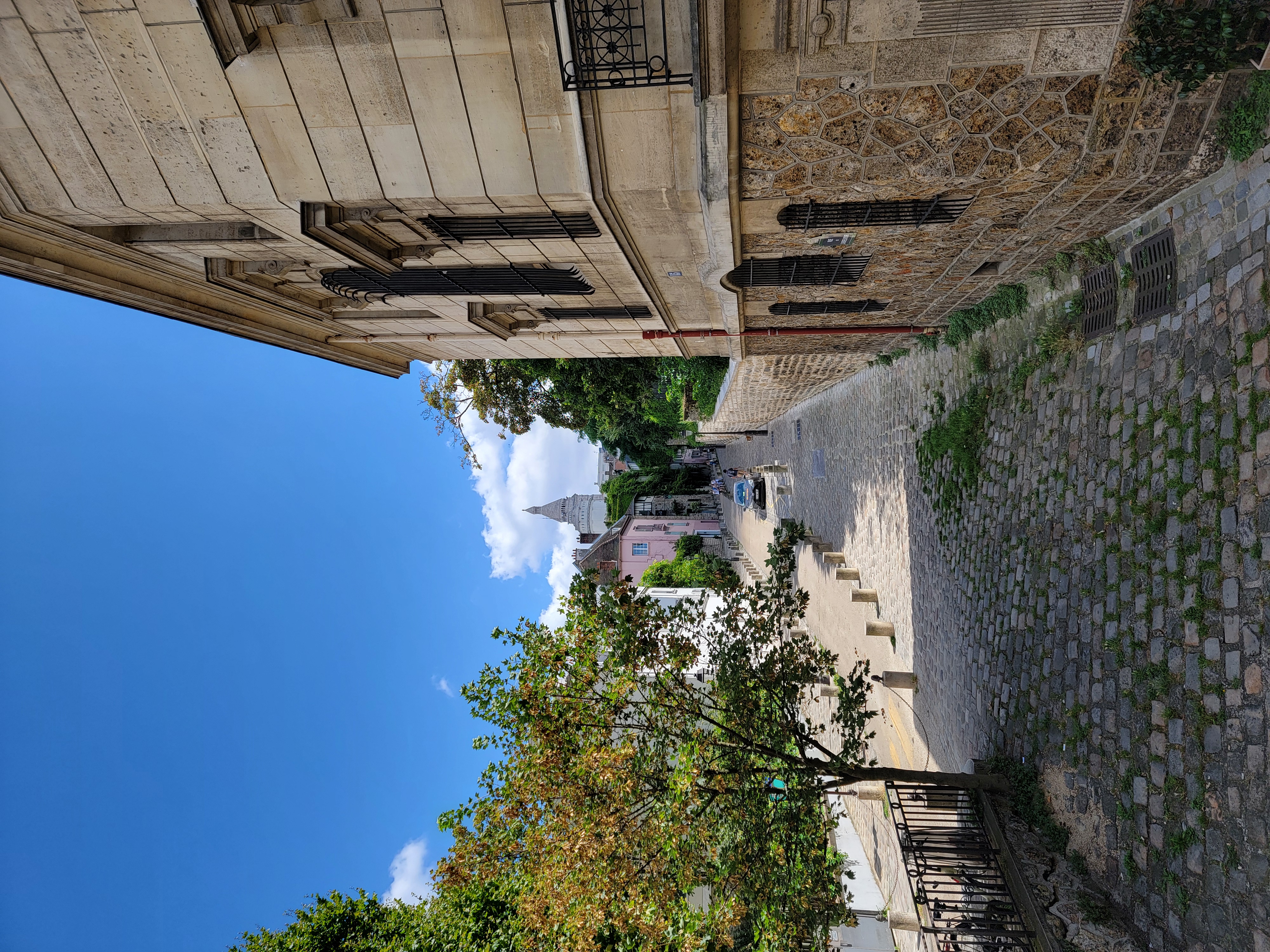

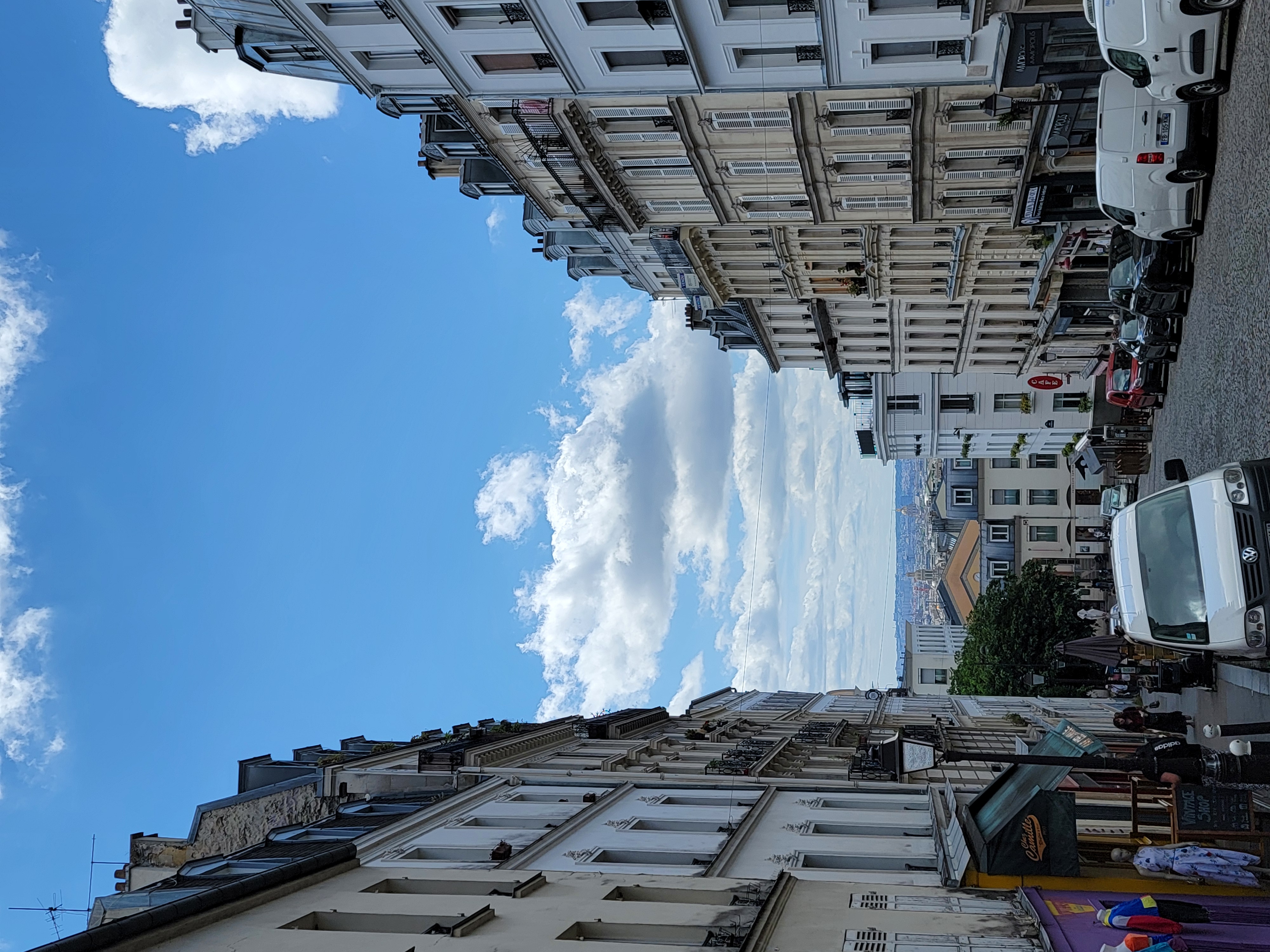
There is a vineyard in the Montmartre area, but it is North-facing and so is uniformly considered to be ‘crappy wine.’ (I am writing this on Day 15, and we passed some grapes over in the Latin Quarter that are in mainly South-facing areas, so that wine, though it doesn’t make many bottles, is considered to be very good wine. Both are owned by the City.) There is a big celebration in Montmartre near the end of September/beginning of October that is a LOT of fun per our guide Hugo that includes a wine parade and has been going on since 1933.
Avenue Junot is Paris’ “little Hollywood” – a number of actors make their homes here.
We came to our last “treat” at this point, which was a macaron store, Carette.
This store has been making macarons for 100 years and they are fresh with a super generous filling.
Just like the Madeleines, these tasted like no macaron we had ever had. Just unbelievably good.
Sacre Coeur was built at the end of the 19th century, to show that Montmartre was now fully part of Paris, not an outlying obstreperous area. It is built out of Fontainbleu stone (I think my notes say?) that is well known for being “self-cleaning” when it rains (so it remains gleaming white).
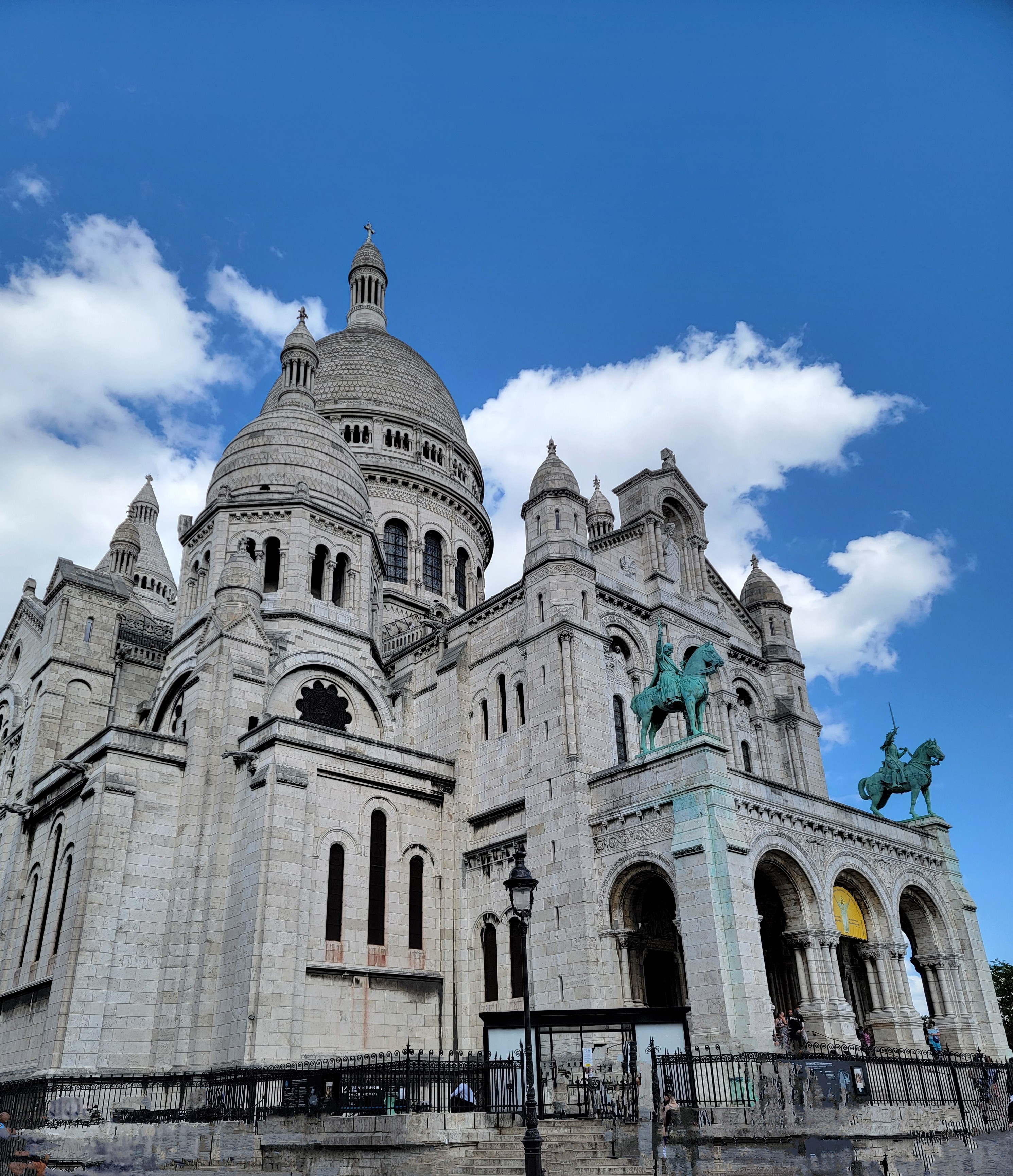


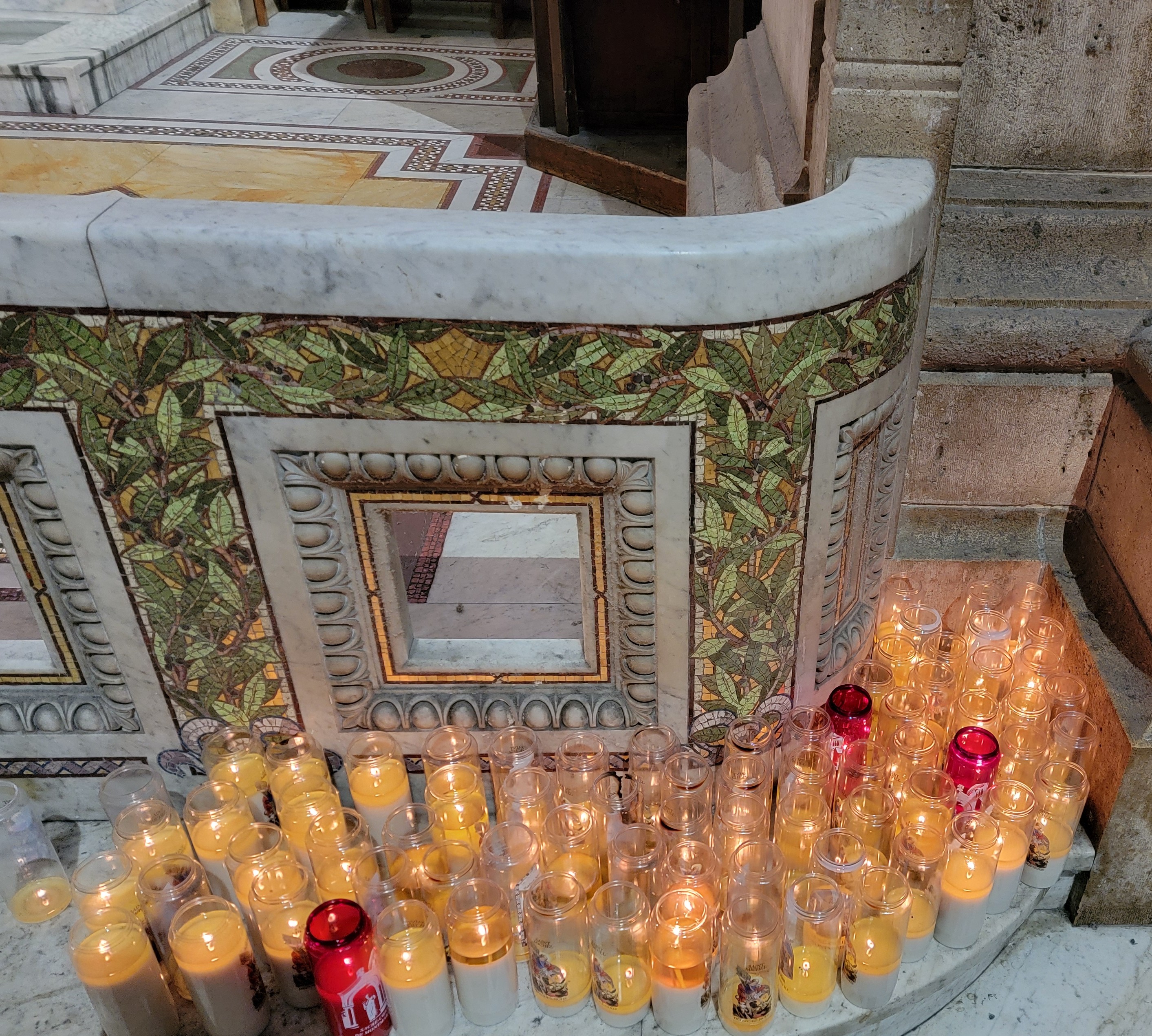





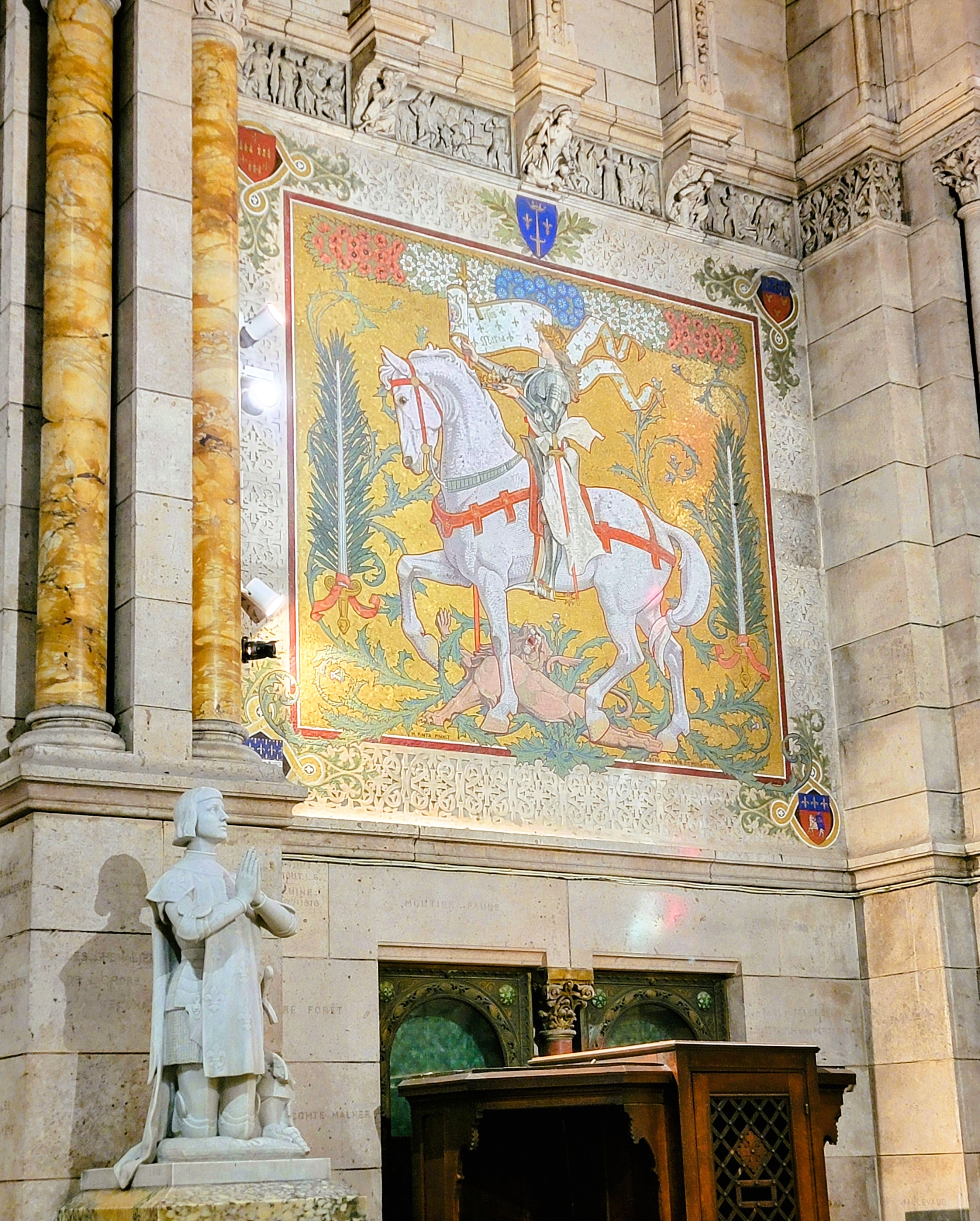

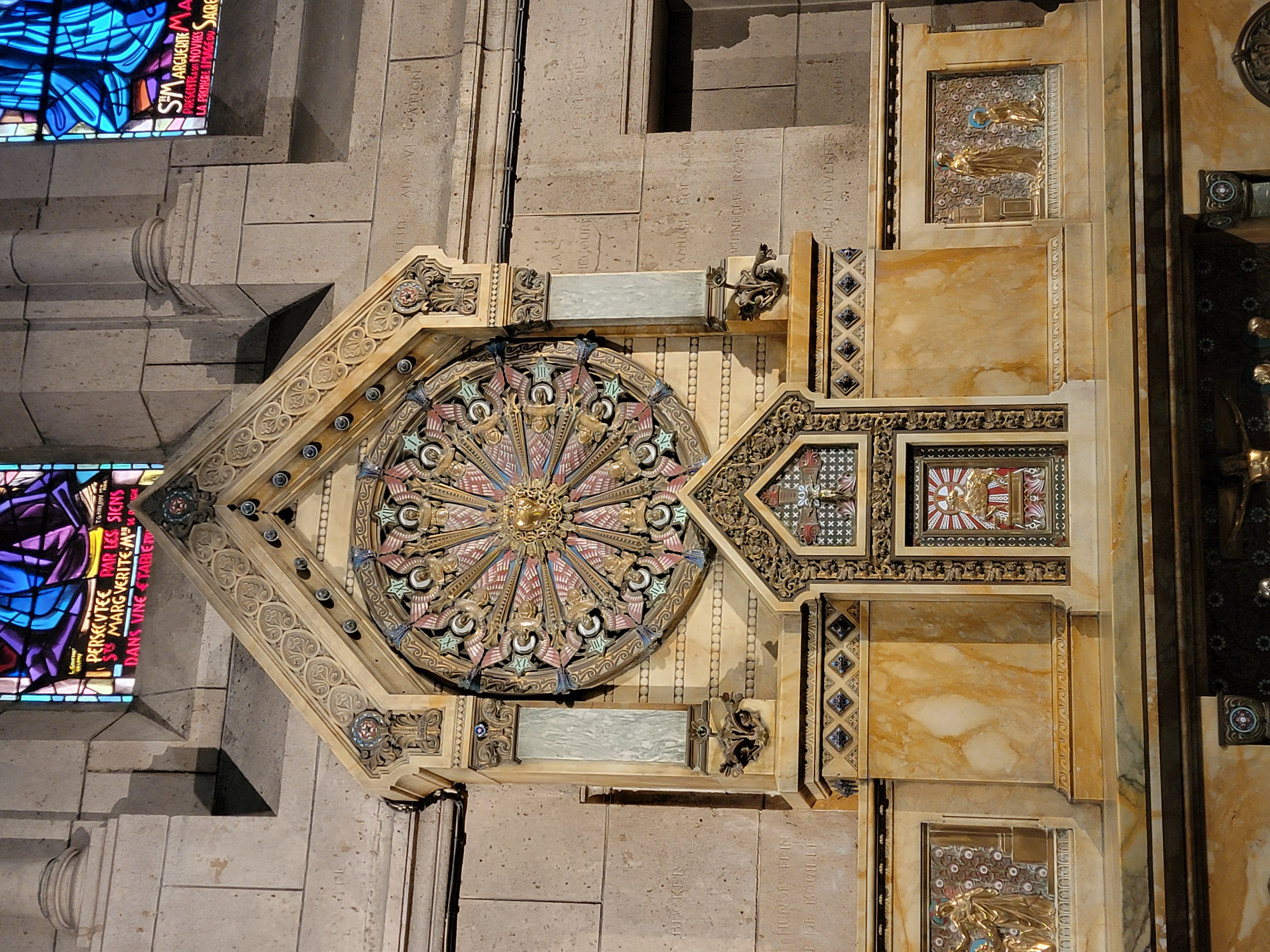
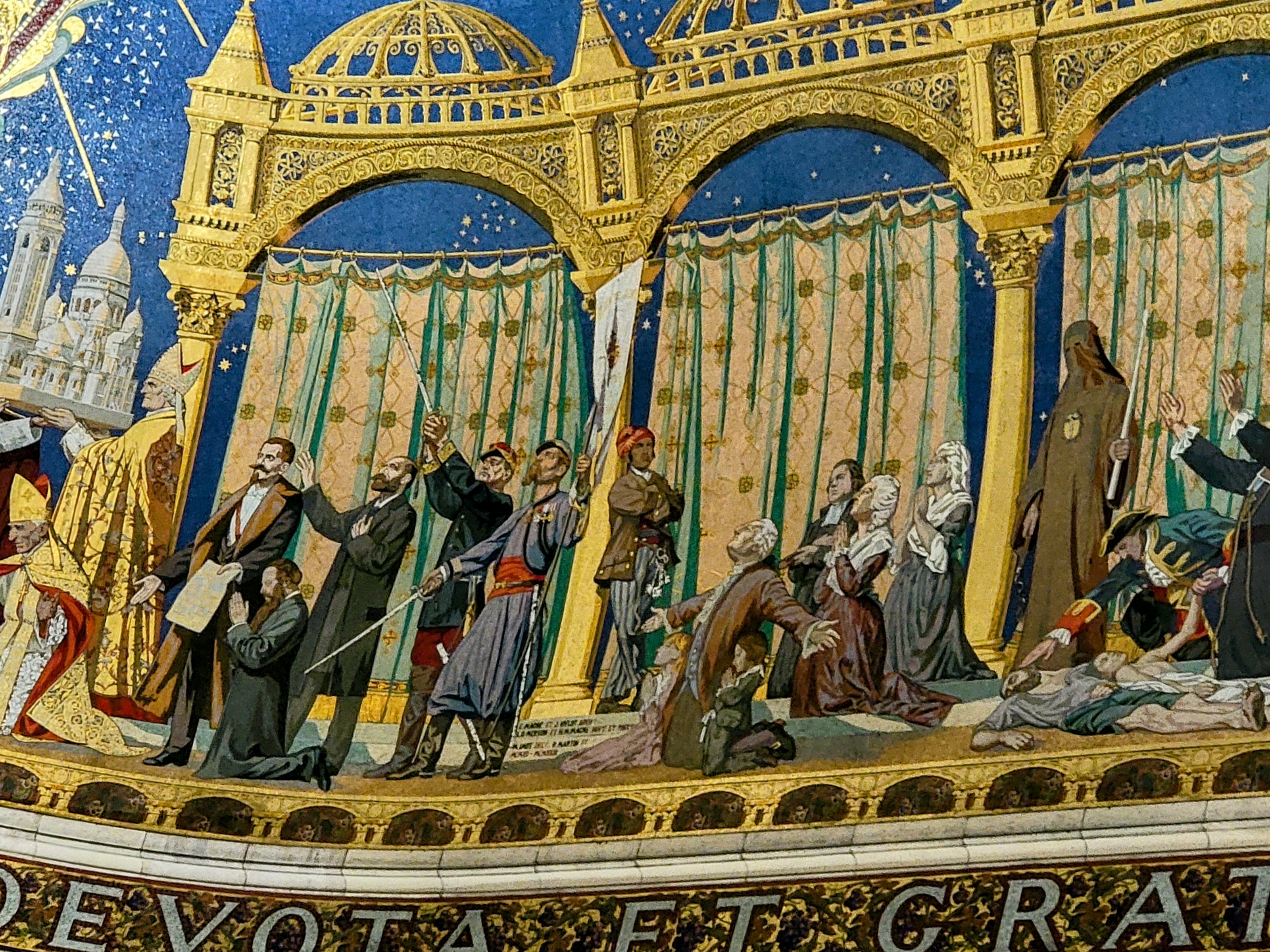
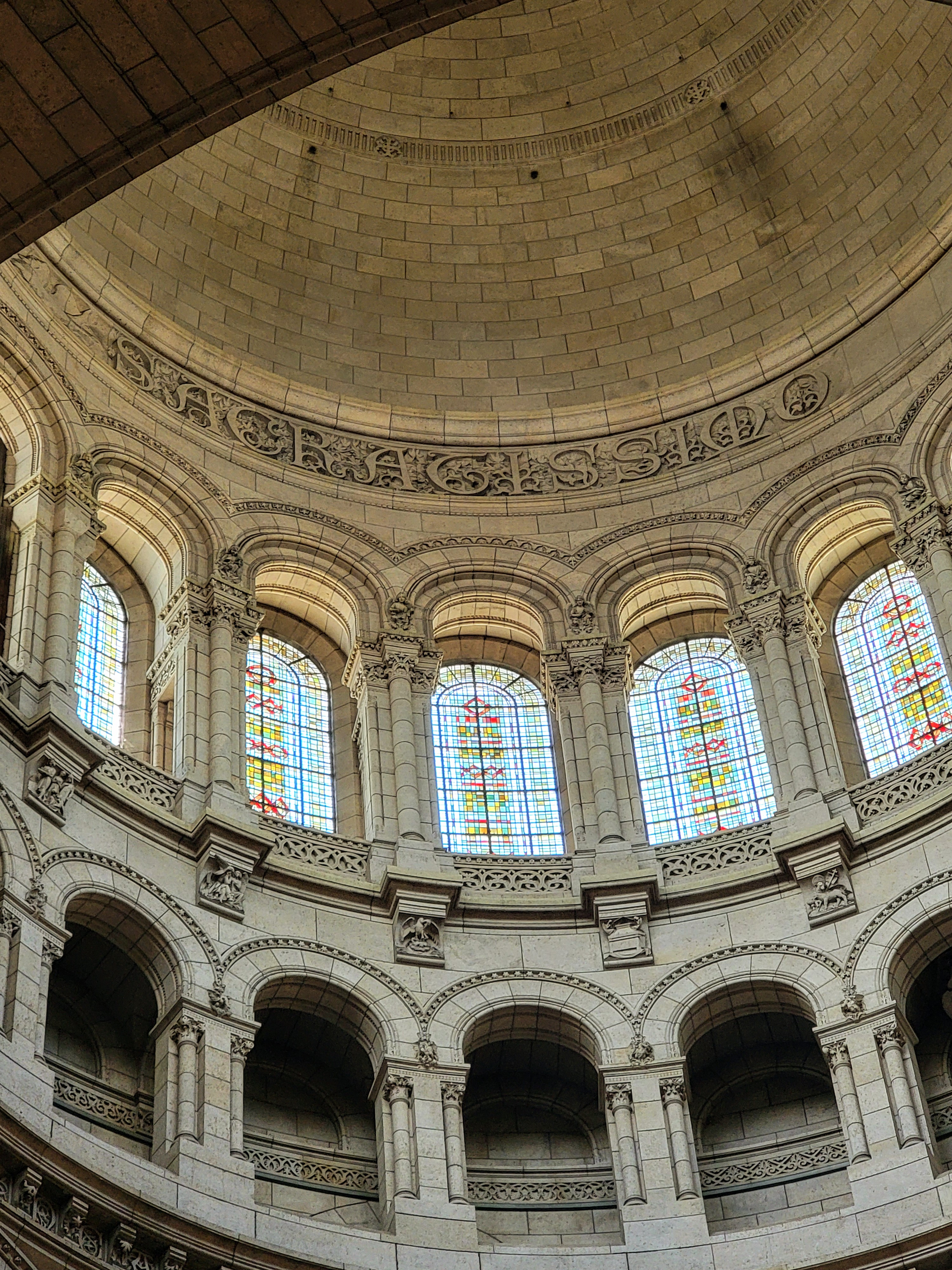
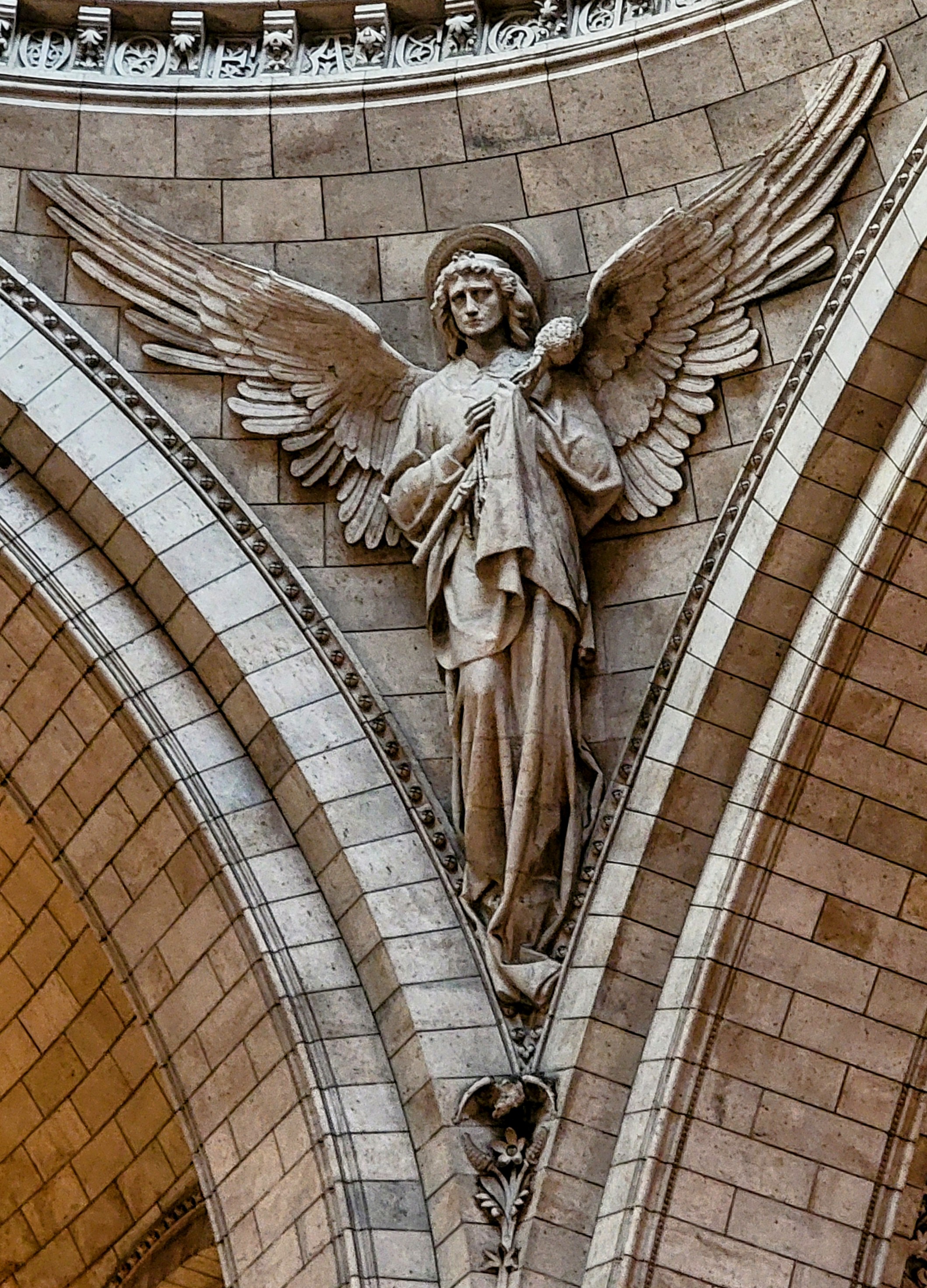
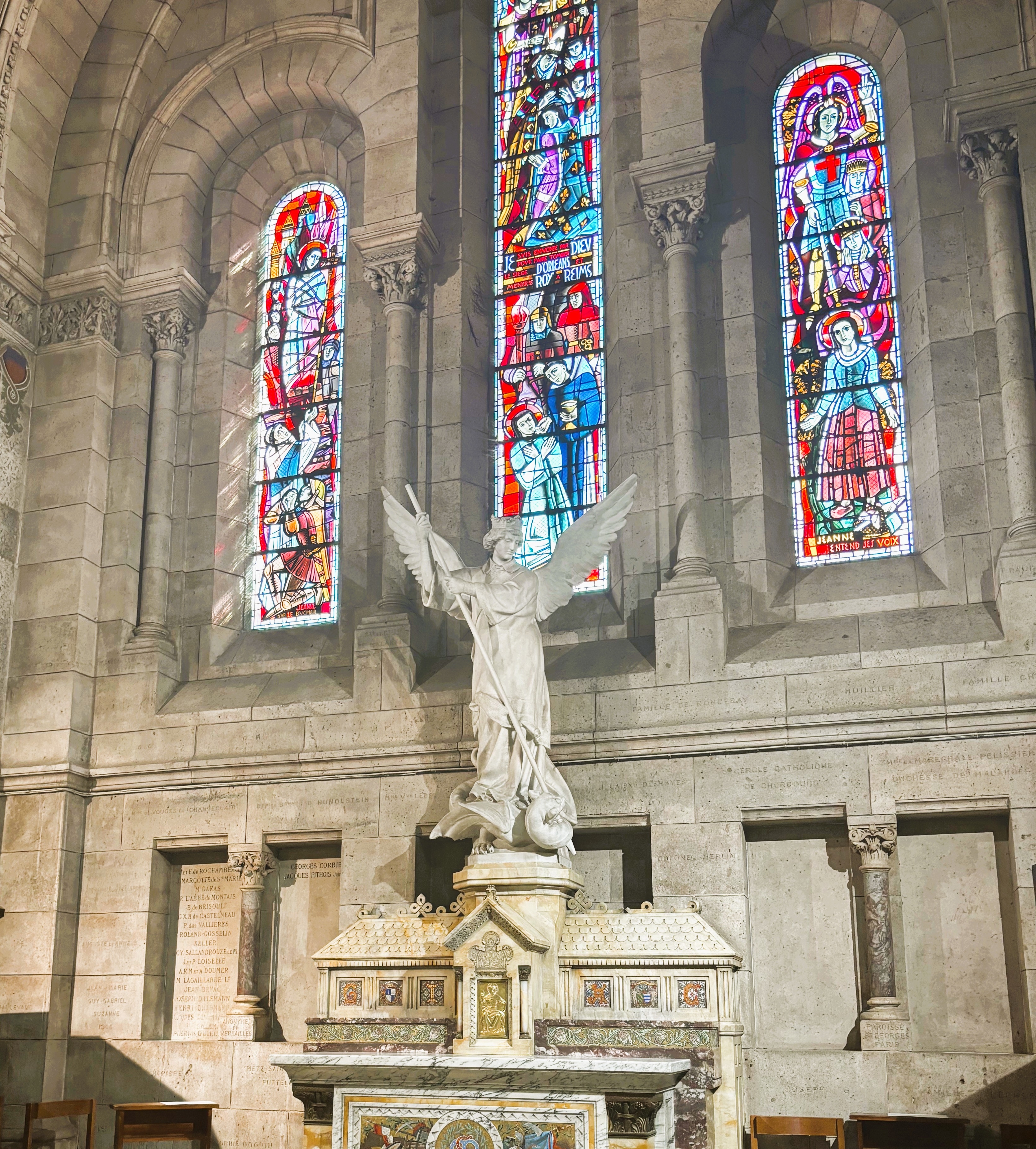
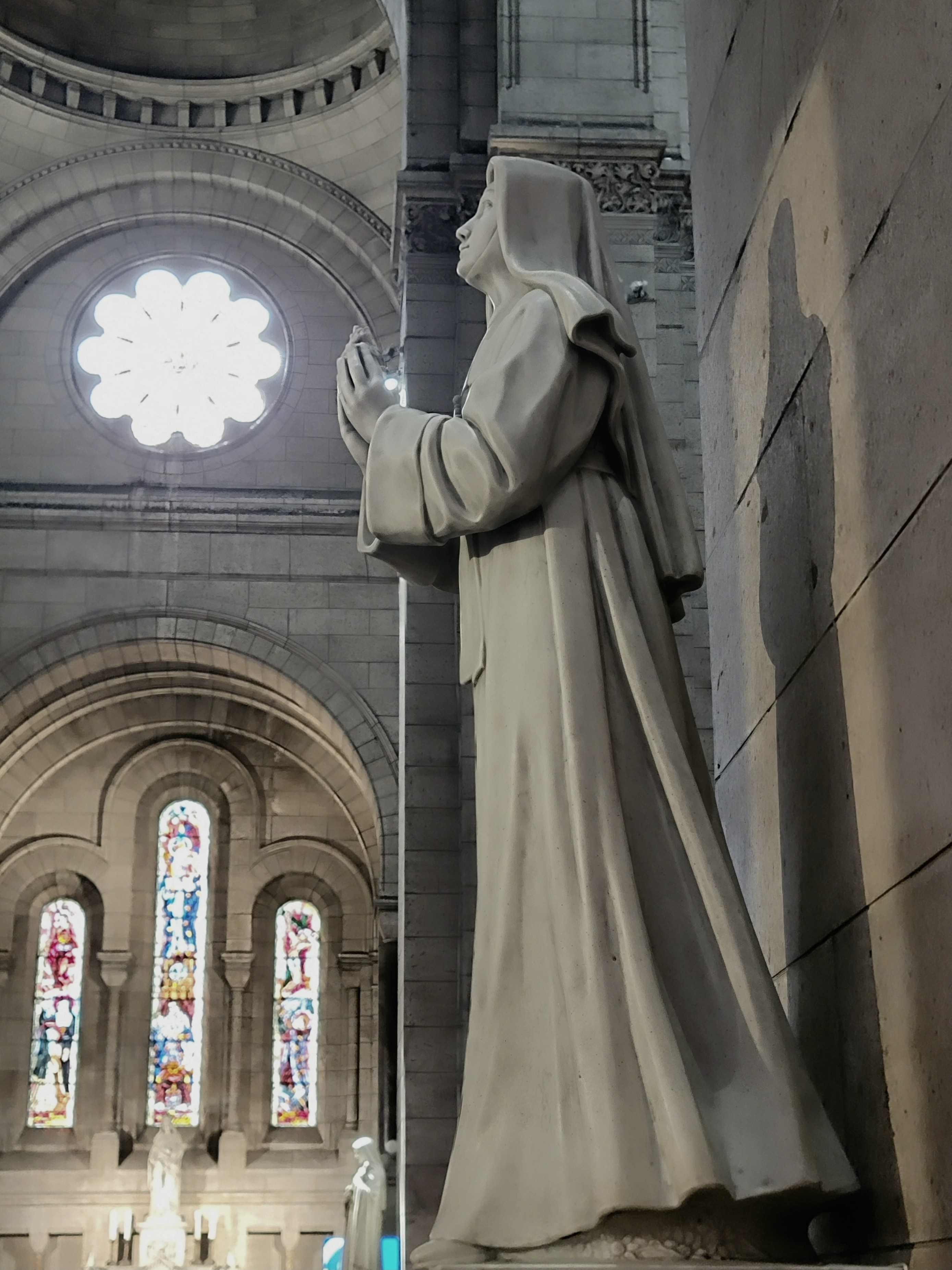
The ribbons made into what looks like a rose window is the “Emblematic Dial” of the Guard of Honor of the Sacred Heart, established by a Visitation nun from Bourg-en-Bresse in 1863. Each day, members of the Guard of Honor choose one hour and, without changing their usual occupations, offer that moment to the Heart of Jesus.
I was VERY taken by the mosaics that you see of the “gentlemen,” the soldier, and the guy leaning against the wall. If you look at the big Jesus mosaic, they are down to the right, in the “closest right” curve of the bottom of the arc. Since there was a service going on I couldn’t get closer to them – but would love to know their story!
Sacre Coeur was blessed by the Pope, and for 135 years, it has had prayers/services 24/7/365 to “atone” for all the “sins” of the Hill. It does close for 1 hour now during the day – though it was 24 hours when he was a kid. The statues on the front are of King Charles (who has his sword upside down and his crown in his hand), and Joan of Arc, victorious.


Leann and the Aments were very brave, and climbed the stairs up to the dome to see out towards the city! 292 steps!!! (What did I do? <Ahem> Edited photos for the blog. Yes, yes I did.)
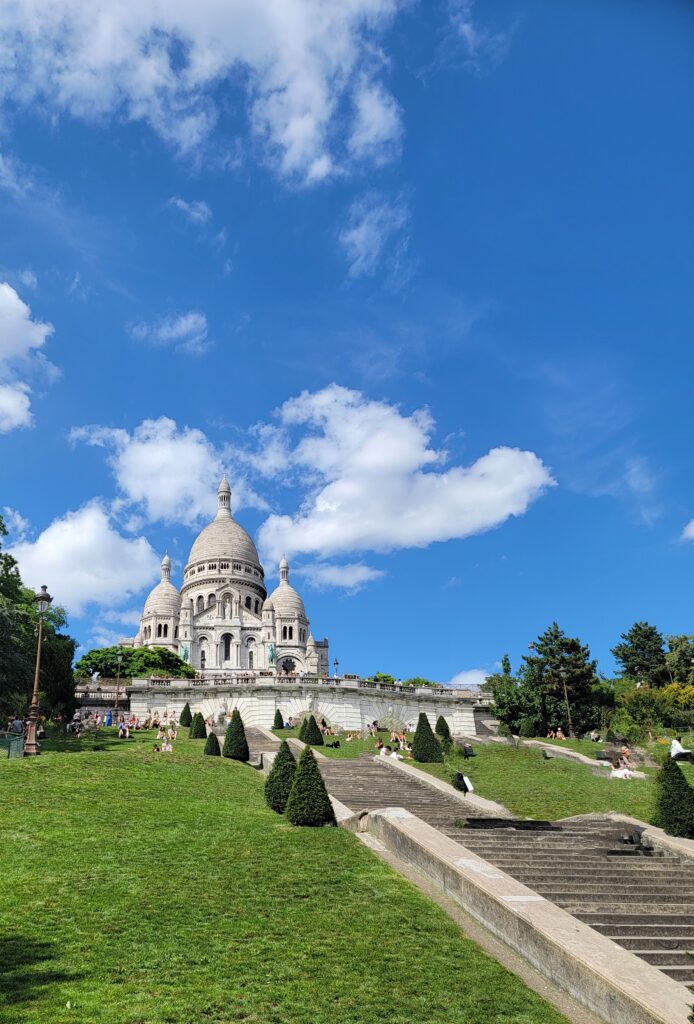

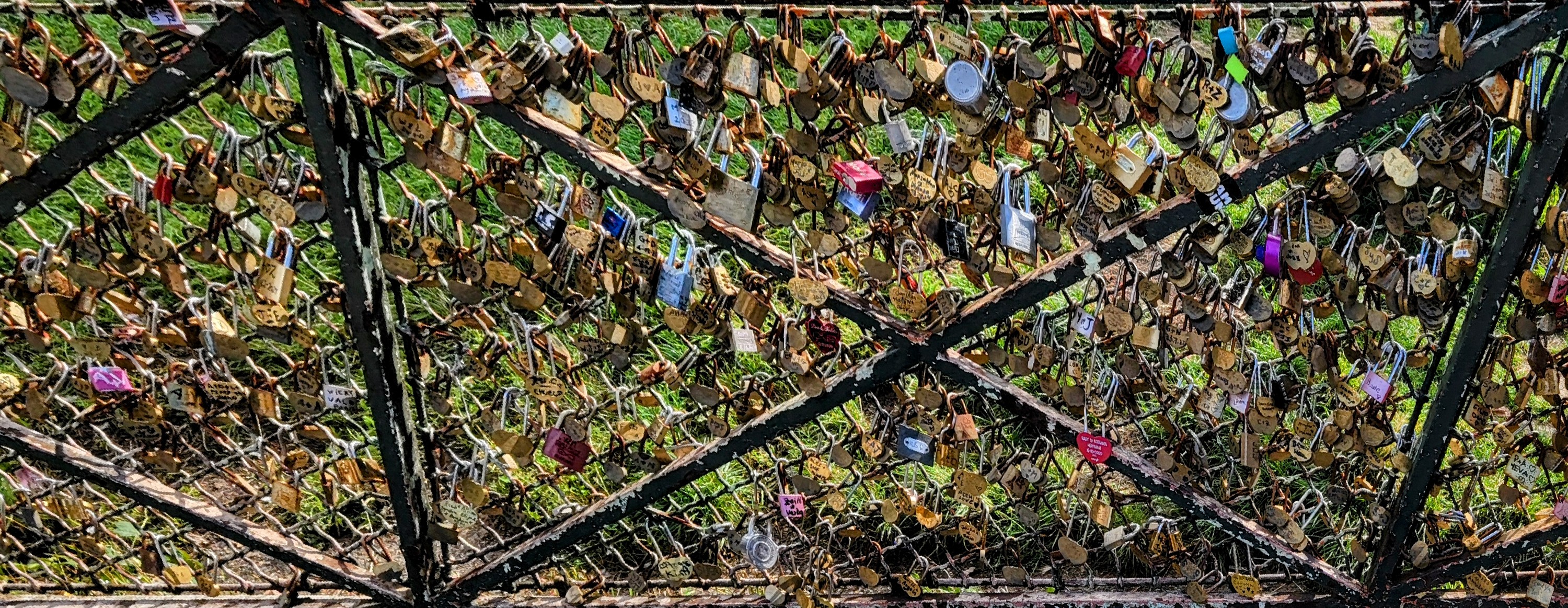

For those who are John Wick fans like myself, as you know, the stairs at Sacre Coeur were used in John Wick 4. On the way down, we passed not only a ton of the locks on the fences, but the carousel. Every time that Herbert and I would travel and we came upon a carousel, he would pay to have me ride it. He knew that I just loved carousels. I have ridden them in Vienna, Central Park, San Francisco, etc. It made me a bit sad, because I realized that what I really loved about riding carousels that we came across while traveling was that Herbert loved that I loved carousels.
We were able to go home for a tiny bit of time (what did we do? Leann took a wee nap. I tried to upload blog photos. Story of my life). Then we headed out to our dinner cruise on the Seine!


When we got out of the Metro, Leann realized that we were right at the “Eternal Flame” statue that stands over the underpass where Princess Diana died. She is a big Princess Di person, and we had written off the idea of making it to this area as it’s pretty out of the way. Come to find out that it’s where our boat was docked!




We had a very serviceable dinner, the live music was *exceptional.* We actually thought that it was recorded, because the violinist was just so outstanding. Bravo, anonymous violinist. :-)
Between dinner and dessert, Leann and I headed up to the top level, particularly so that we could see the Eiffel Tower do its “twinkle thing”! Since I’ve been at this blog for the better part of 7 hours (the most arduous part being the photo uploading), I’m just going to plop all the “dinner cruise related” photos here, and, perhaps, I will re-order them if I find time. Quick notes:
*There were hundreds of people out picnicking along the Seine. They waved, sent us “heart hands,” etc. It was so great to see – people really enjoying the evening and the (almost?) clean river.
*The very industrial-looking grey weird building is the Ministry of Finance.
*There are river boats along the canal of the Seine where people live – and some are rented out as VRBOs.
*The stands were for the Opening Ceremony.
*The “original” Statue of Liberty (remember, France gave her to the U.S.) is about 1/10th? the size of the one in New York.
*Some of the photos are a little blurry – sorry about that. :-) Also if you see the “lines” horizontally, it’s because we were shooting through the window at our table.
*Loved the colored statues :-)
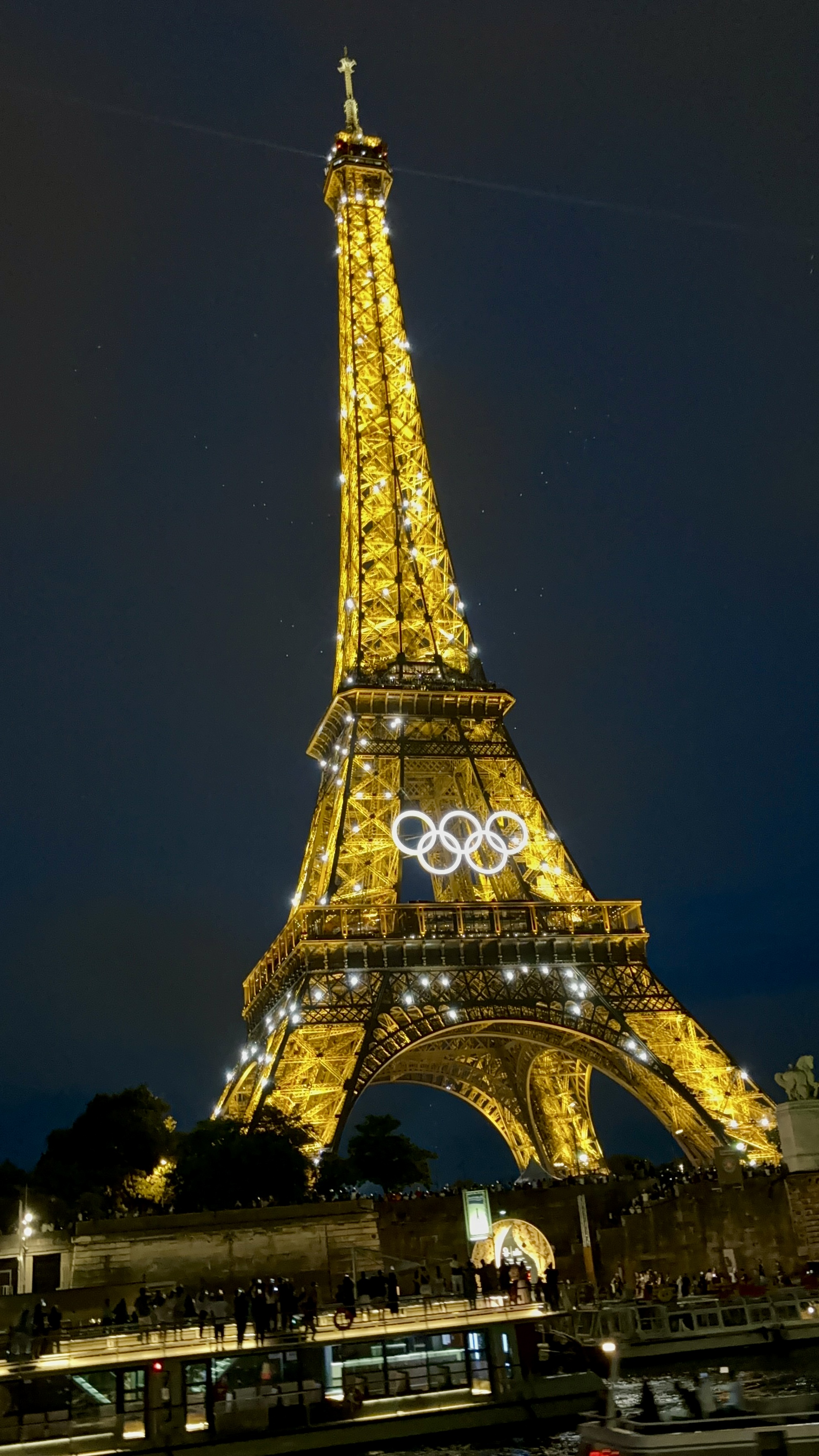
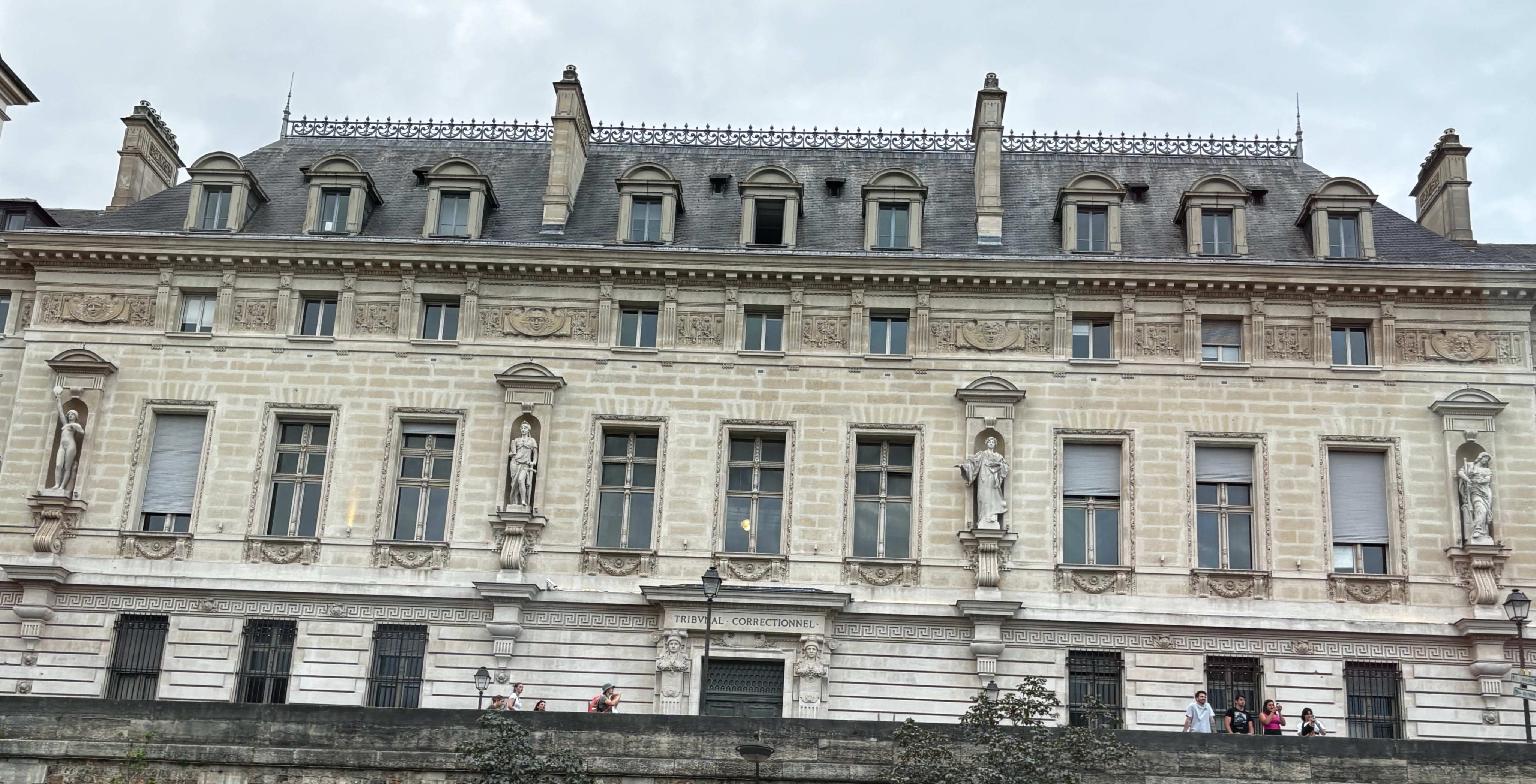

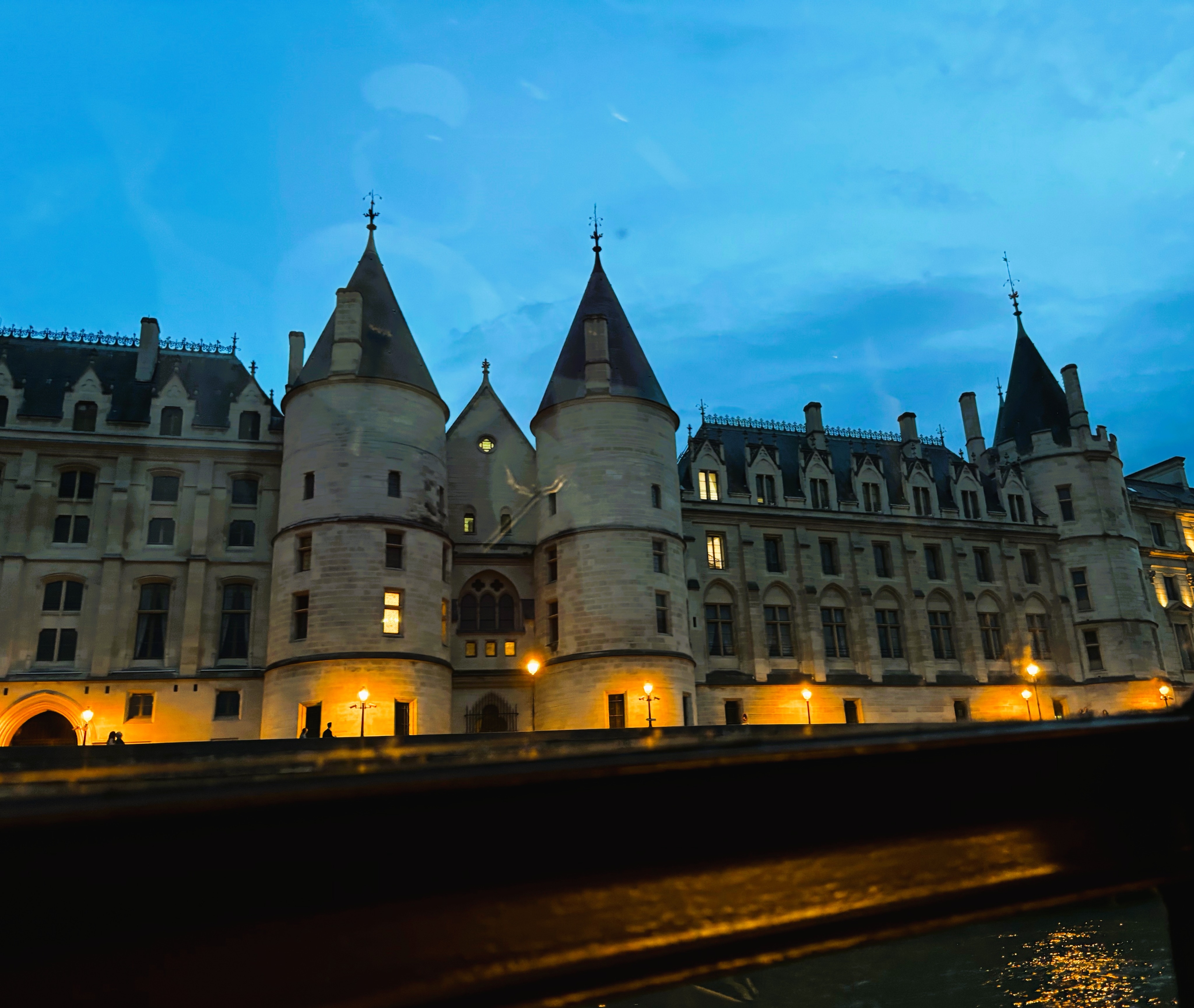

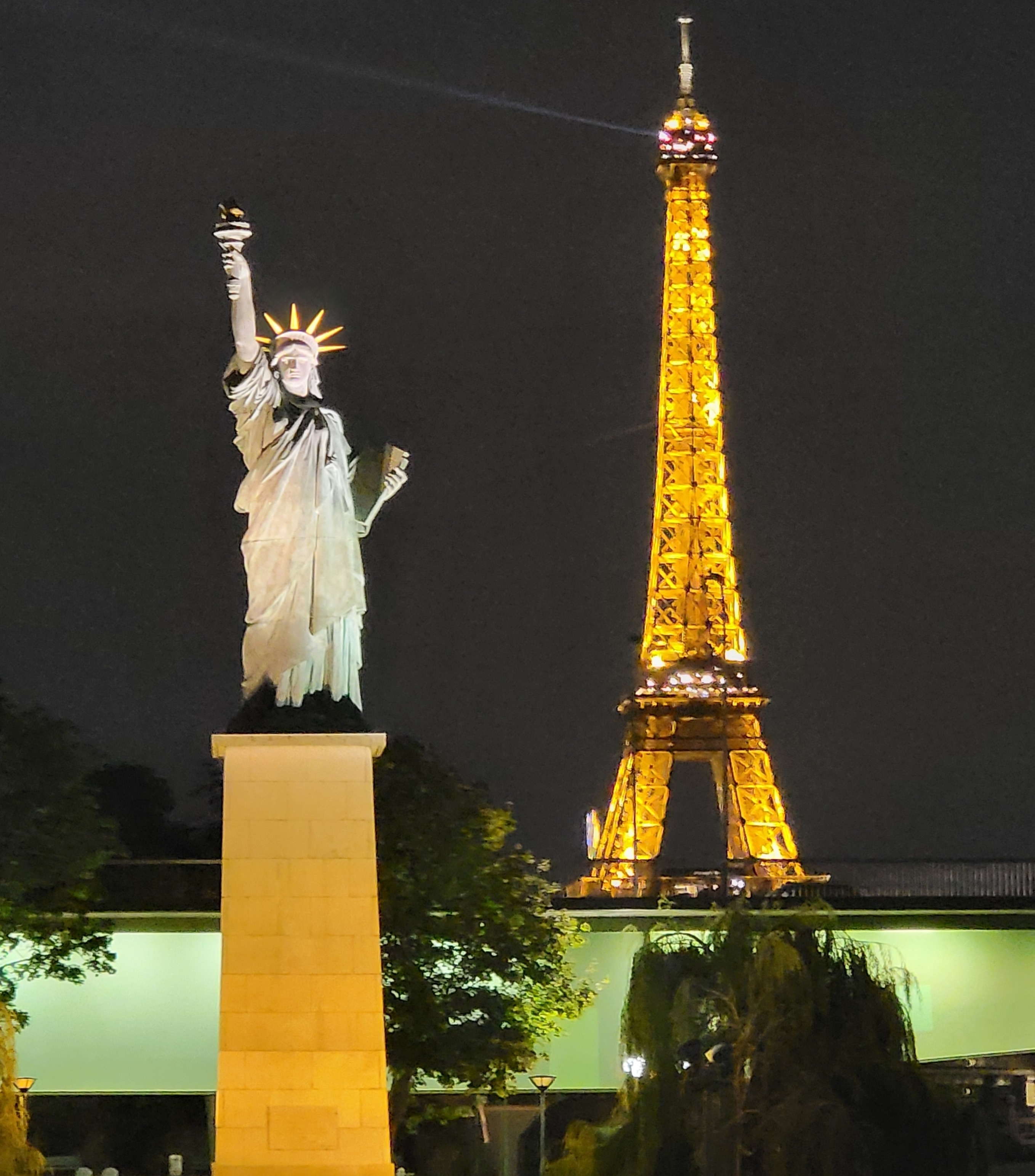

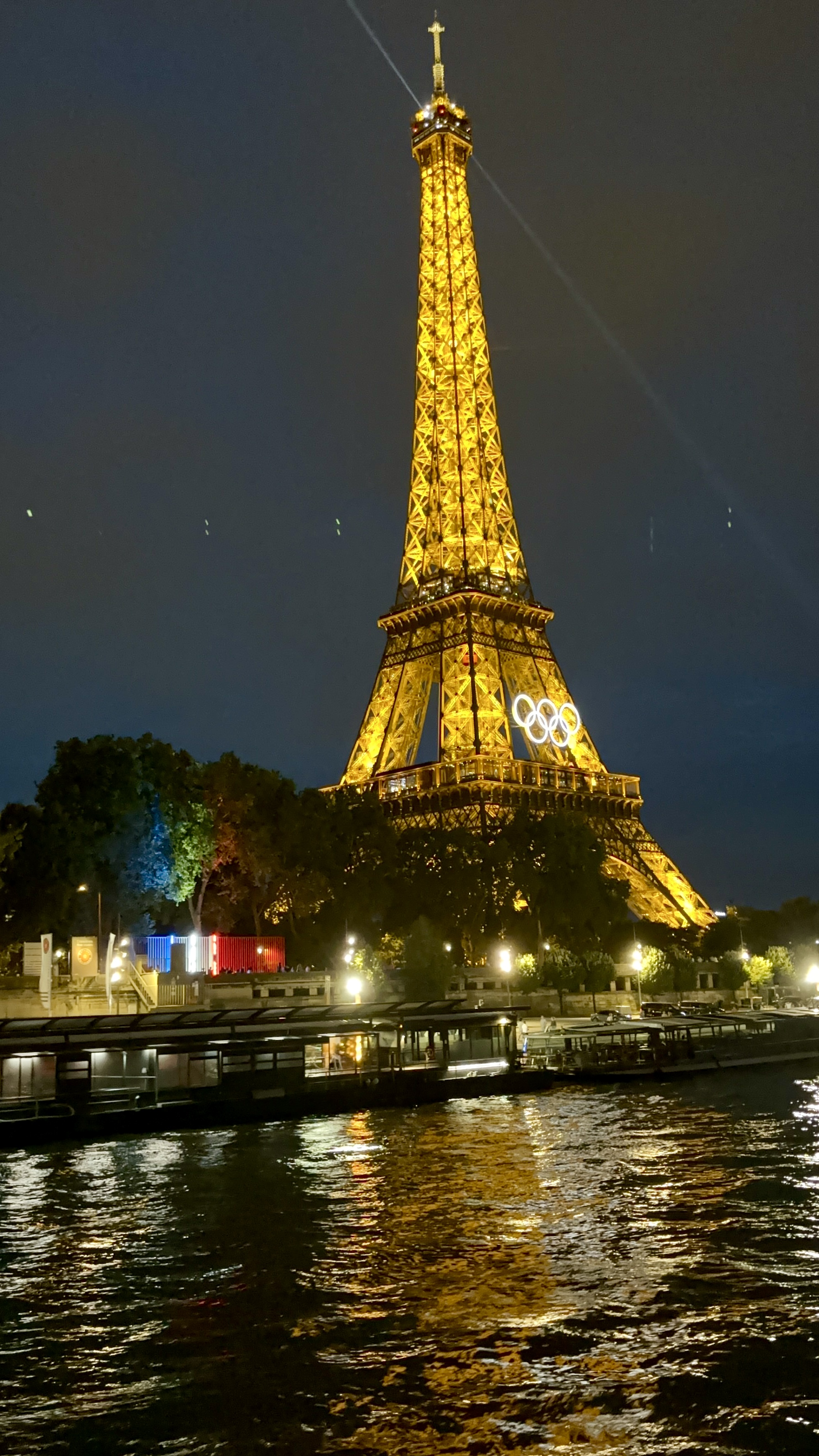









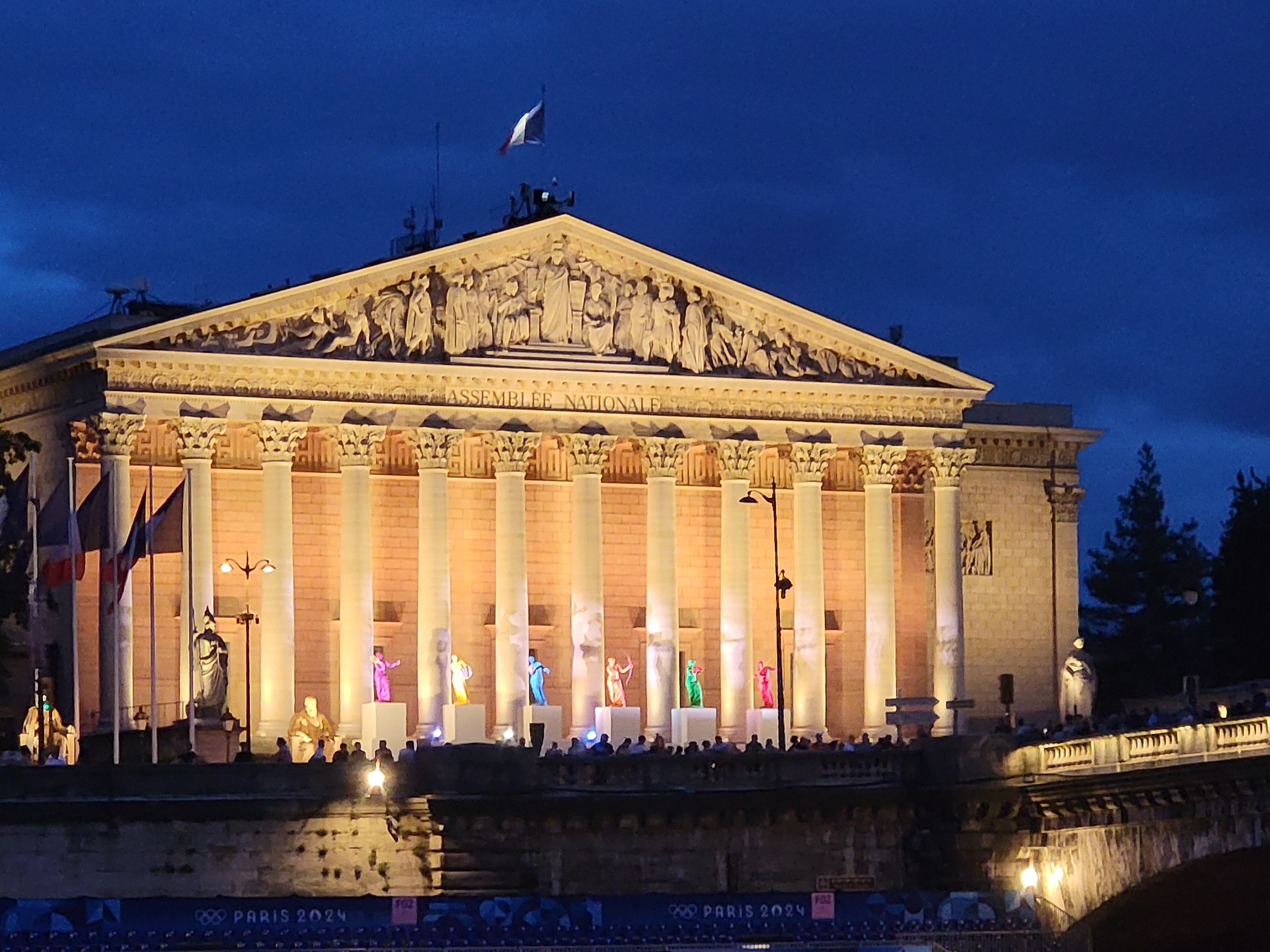

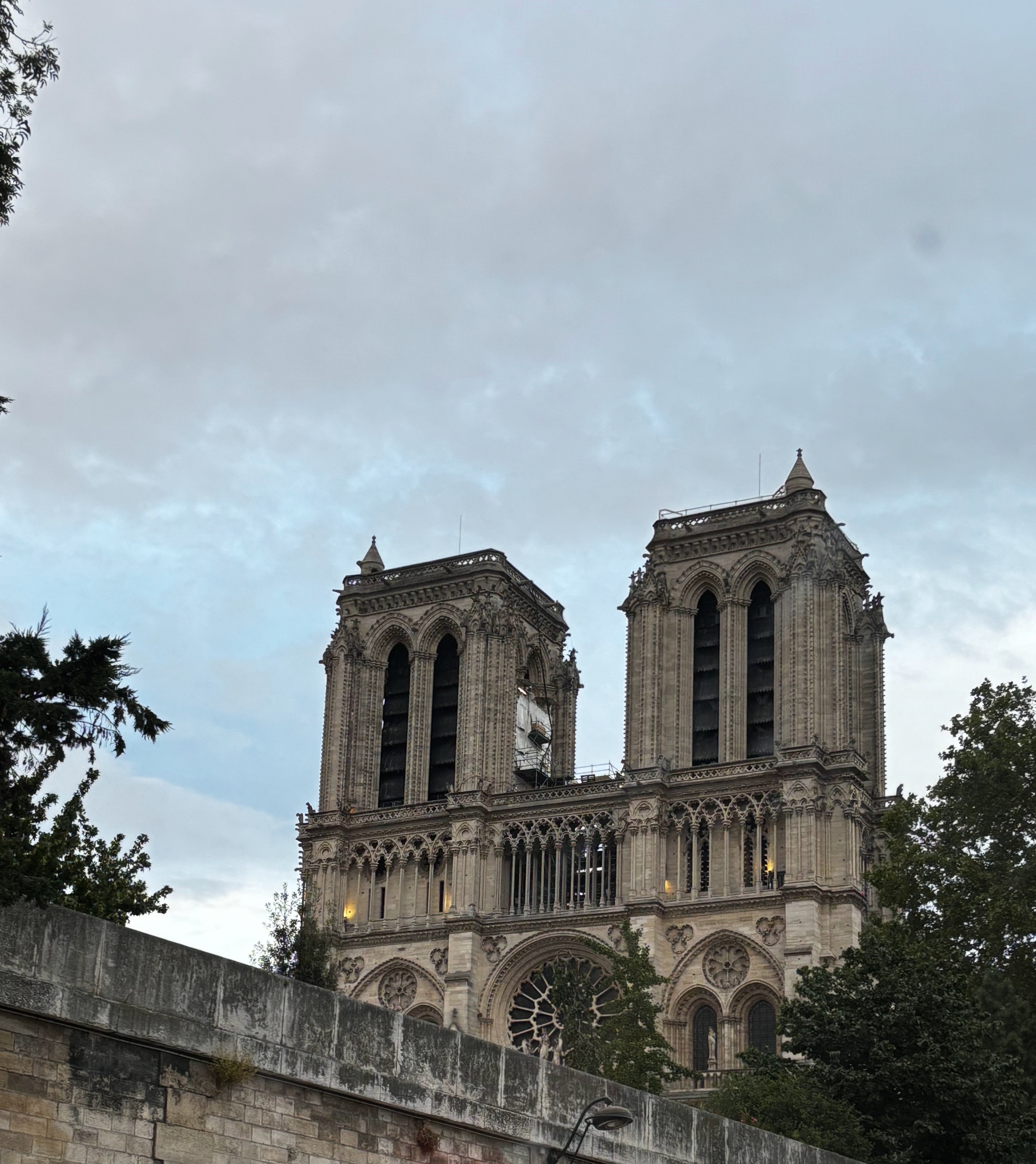

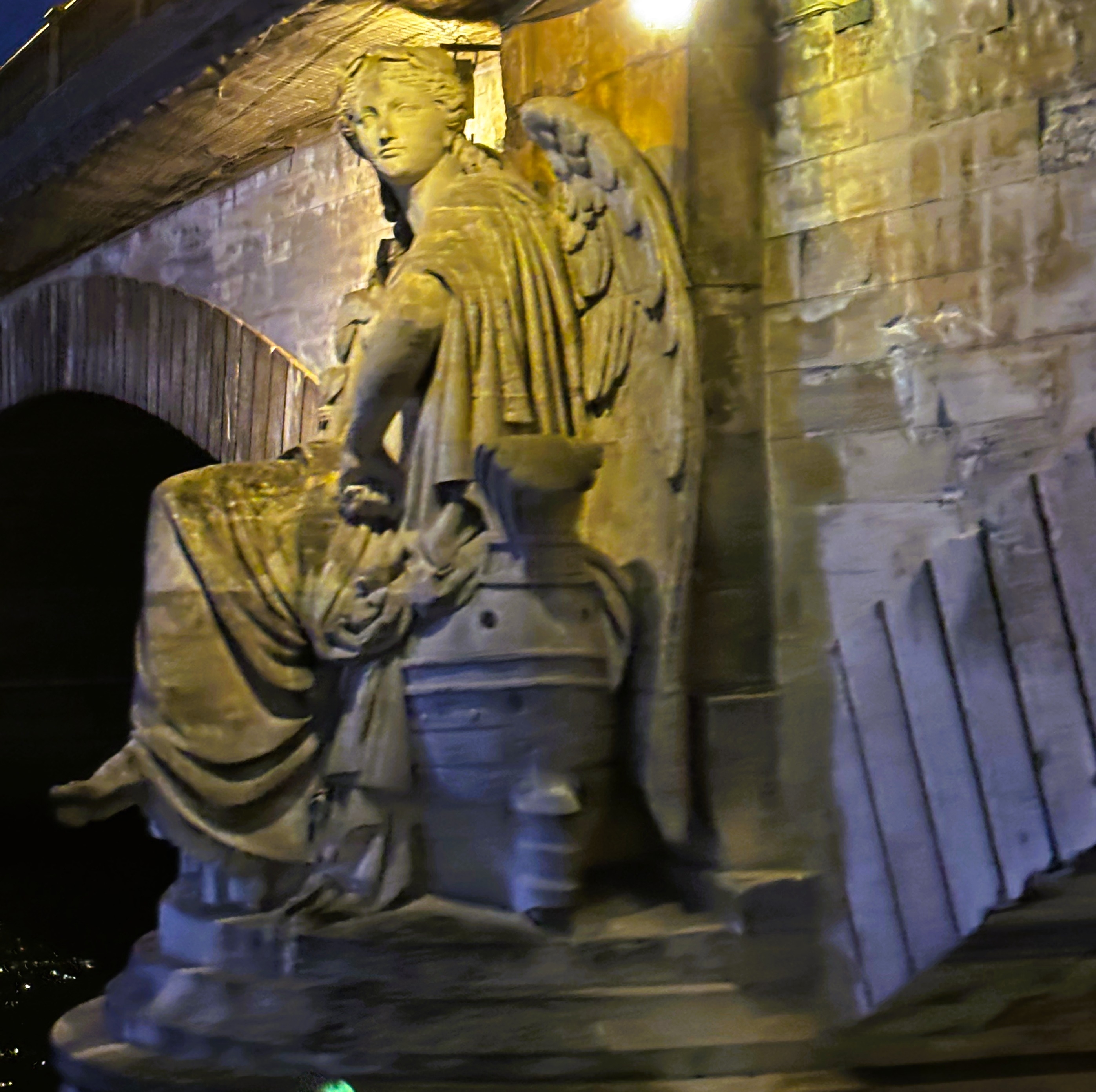

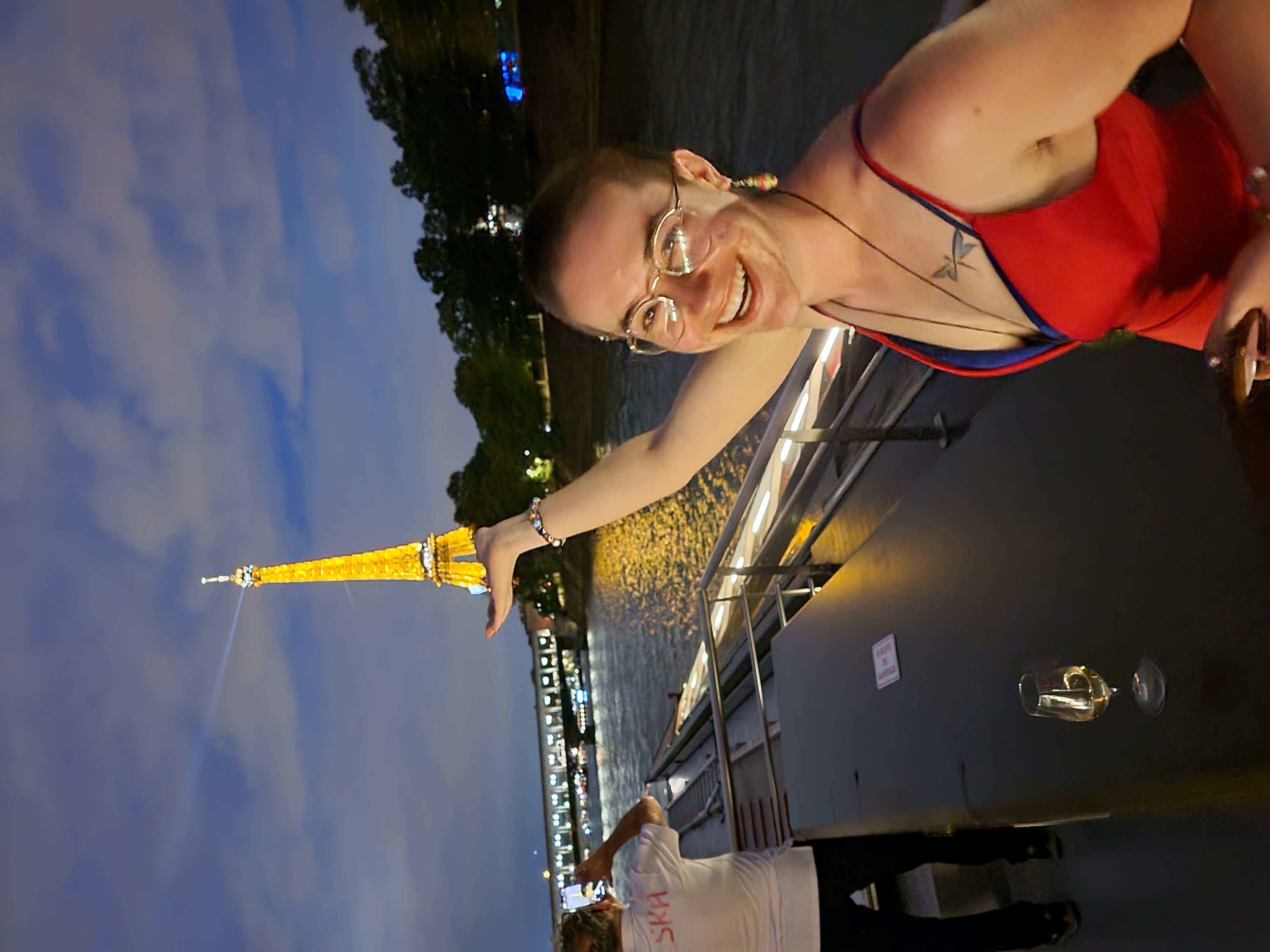


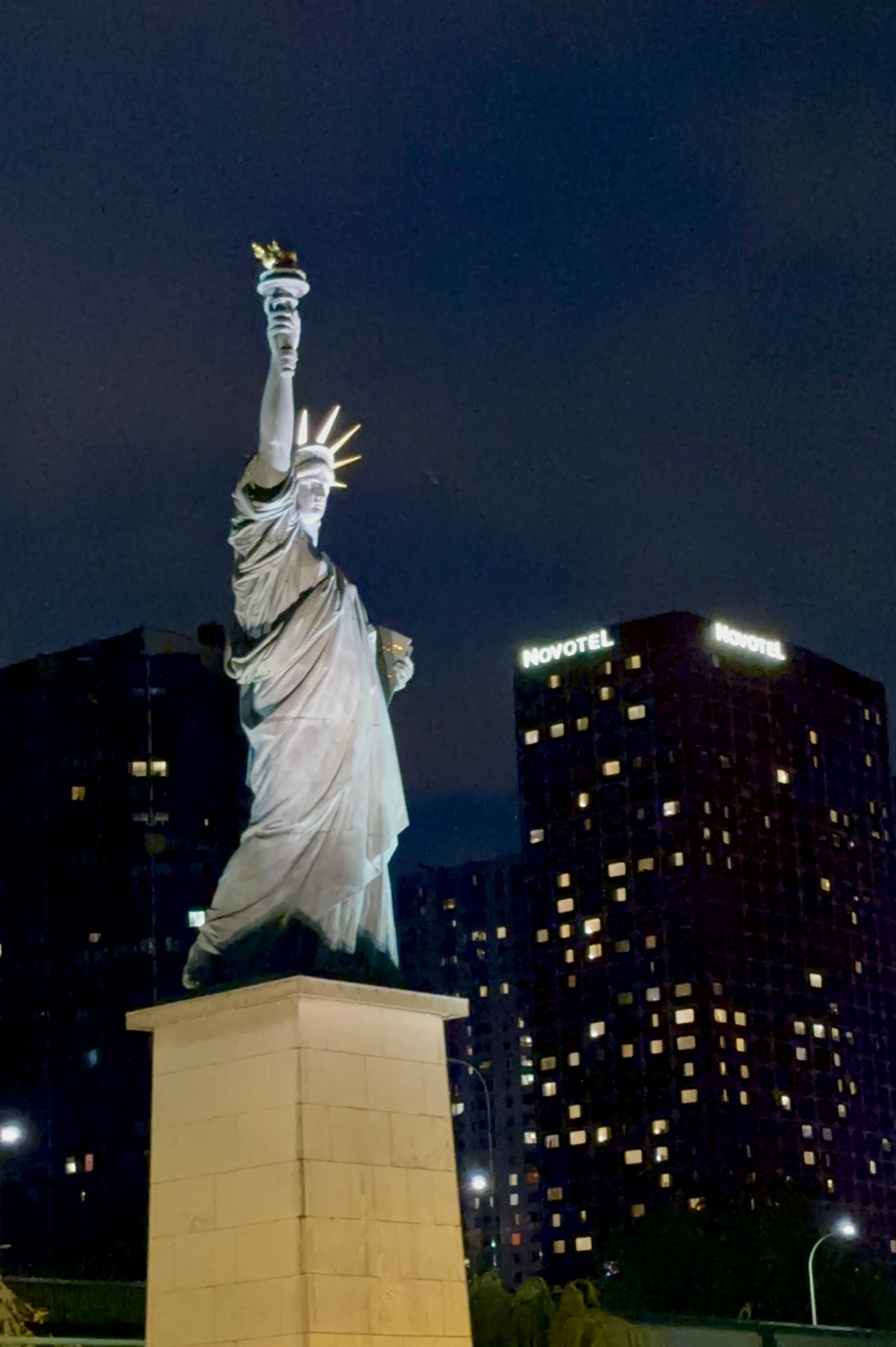
Day 15 steps: 18,957 (Yes, I know that I am writing about Day 14, but I keep forgetting to write in the steps so I thought I would be proactive)
On Day 15 we had a lovely tour of the Latin Quarter (spoiler alert – it has nothing to do with salsa and tacos).
On Day 16, we will PACK in the morning (boo hoo), then we go to what is going to (hopefully) be a very exciting men’s water polo game, and (since we will be packed) we will then (again, hopefully) go to two things I really want to do in the Marais.
Then, to bed, as we have to catch an Uber (gack) at 5 a.m. to the airport.




